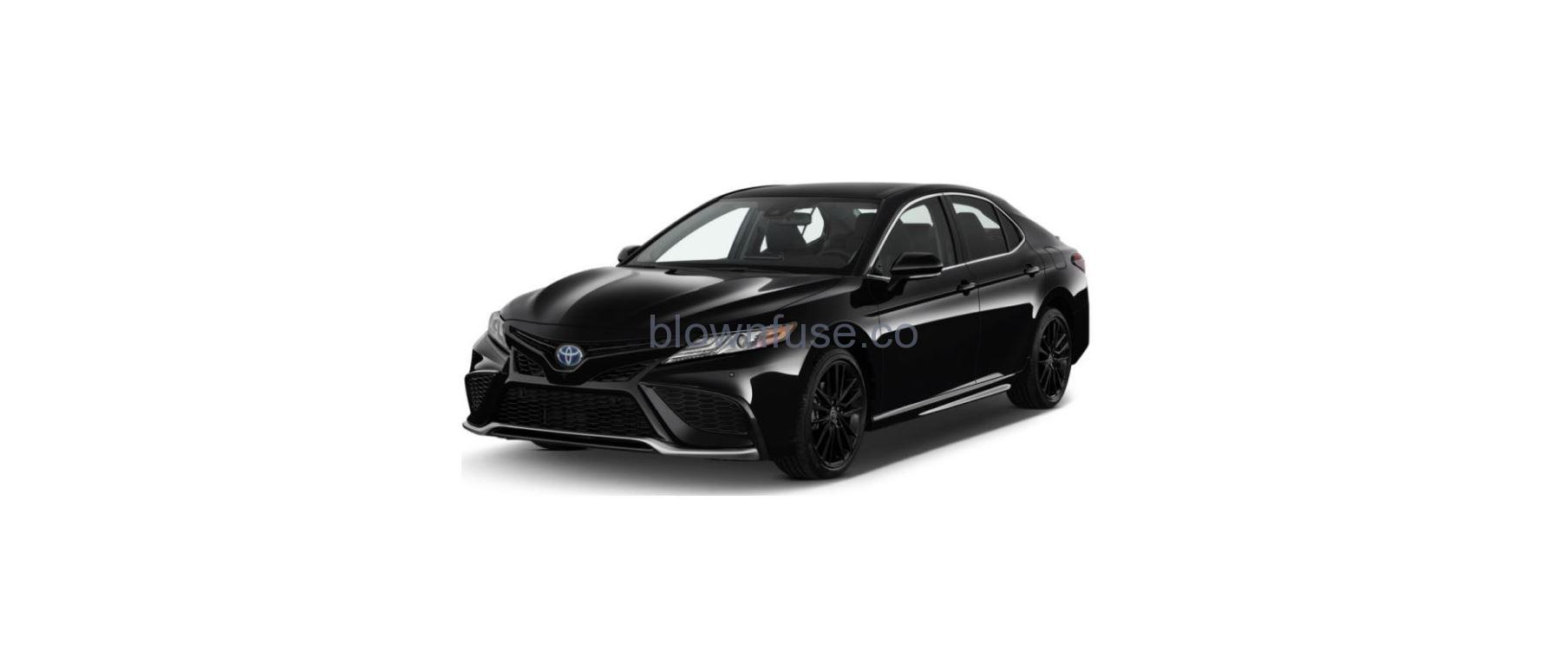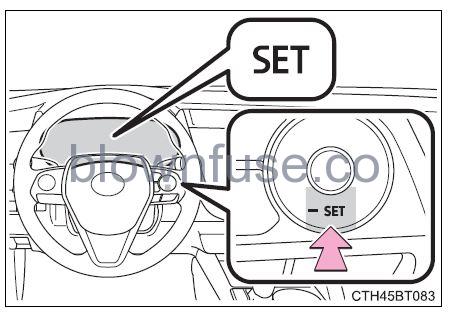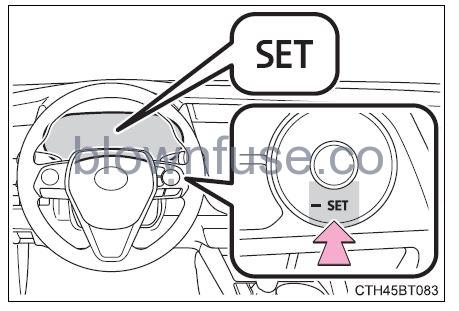2022 Toyota Camry Safety Sense Driving Support Systems User Manual

Toyota Safety Sense 2.5+
The Toyota Safety Sense 2.5+ consists of the following drive assist systems and contributes to a safe and comfortable driving experience:
Driving assist system
- PCS (Pre-Collision System) P. 254
- LTA (Lane Tracing Assist) P. 270
- AHB (Automatic High Beam) P. 236
- RSA (Road Sign Assist) (if equipped) P. 285
- Dynamic radar cruise control with full-speed range (if equipped) P. 290
- Dynamic radar cruise control (if equipped) P. 306
WARNING
Toyota Safety Sense 2.5+ The Toyota Safety Sense 2.5+ is designed to operate under the assumption that the driver will drive safely, and is designed to help reduce the impact on the occupants and the vehicle in the case of a collision or assist the driver in normal driving conditions. As there is a limit to the degree of recognition accuracy and control performance that this system can provide, do not overly rely on this system. The driver is always responsible for paying attention to the vehicle’s surroundings and driving safely.
Sensors
Two types of sensors, located behind the front grille and windshield, detect information necessary to operate the drive assist systems.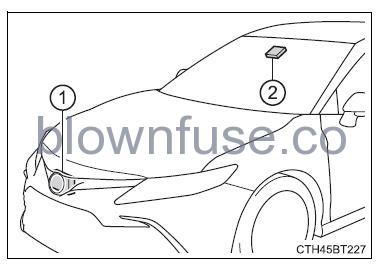
- Radar sensor
- Front camera
WARNING
- To avoid malfunction of the radar sensor Observe the following precautions.
Otherwise, the radar sensor may not operate properly, possibly leading to an accident resulting in death or serious injury.- Keep the radar sensor and the radar sensor cover clean at all times.
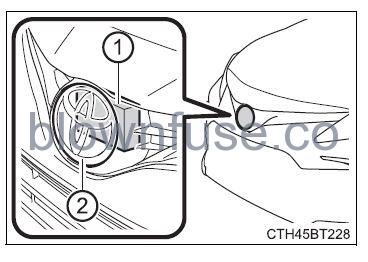
- Radar sensor
- Radar sensor cover
If the front of the radar sensor or the front or back of the radar sensor cover is dirty or covered with water droplets, snow, etc., clean it. Clean the radar sensor and radar sensor cover with a soft cloth to avoid damaging them.
- Keep the radar sensor and the radar sensor cover clean at all times.
- Do not attach accessories, stickers (including transparent stickers), or other items to the radar sensor, radar sensor cover, or surrounding area.
- Do not subject the radar sensor or its surrounding area to a strong impact. If the radar sensor, front grille, or front bumper has been subjected to a strong impact, have the vehicle inspected by your Toyota dealer.
- Do not disassemble the radar sensor.
- Do not modify or paint the radar sensor or radar sensor cover.
- In the following cases, the radar sensor must be recalibrated. Contact your Toyota dealer for details.
- When the radar sensor or front grille is removed and installed or replaced
- When the front bumper is replaced
WARNING
- To avoid malfunction of the front camera Observe the following precautions.
Otherwise, the front camera may not operate properly, possibly leading to an accident resulting in death or serious injury.- Keep the windshield clean at all times.
- If the windshield is dirty or covered with an oily film, water droplets, snow, etc., clean the windshield.
- If a glass coating agent is applied to the windshield, it will still be necessary to use the windshield wipers to remove water droplets, etc. from the area of the windshield in front of the front camera.
- If the inner side of the windshield where the front camera is installed is dirty, contact your Toyota dealer.
- Keep the windshield clean at all times.
- Do not attach objects, such as stickers, transparent stickers, etc., to the outer side of the windshield in front of the front camera (the shaded area in the illustration).

- A: From the top of the windshield to approximately 0.4 in. (1 cm) below the bottom of the front camera
- B: Approximately 7.9 in. (20 cm) (Approximately 4.0 in. [10 cm] to the right and left from the center of the front camera)
- If the part of the windshield in front of the front camera is fogged up or covered with condensation or ice, use the windshield defogger to remove the fog, condensation, or ice. (P. 383, 389, 397)
- If water droplets cannot be properly removed from the area of the windshield in front of the front camera by the windshield wipers, replace the wiper insert or wiper blade.
- Do not attach window tint to the windshield.
- Replace the windshield if it is damaged or cracked.
- After replacing the windshield, the front camera must be recalibrated. Contact your Toyota dealer for details.
- Do not allow liquids to contact the front camera.
- Do not allow bright lights to shine into the front camera.
- Do not dirty or damage the front camera.
- When cleaning the inside of the windshield, do not allow glass cleaner to contact the lens of the front camera. Also, do not touch the lens.
- If the lens is dirty or damaged, contact your Toyota dealer.
WARNING
- Do not subject the front camera to a strong impact.
- Do not change the installation position or direction of the front camera or remove it.
- Do not disassemble the front camera.
- Do not modify any components of the vehicle around the front camera (inside rearview mirror, etc.) or ceiling.
- Do not attach any accessories to the hood, front grille, or front bumper that may obstruct the front camera. Contact your Toyota dealer for details.
- If a surfboard or other long object is to be mounted on the roof, make sure that it will not obstruct the front camera.
- Do not modify the headlights or other lights.
If a warning message is displayed on the multi-information display
A system may be temporarily unavailable or there may be a malfunction in the system.
- In the following situations, perform the actions specified in the table. When the normal operating conditions are detected, the message will disappear and the system will become operational.
If the message does not disappear, contact your Toyota dealer.Situation Action When the area around a camera is covered with dirt, moisture (fogged up, covered with condensation, ice, etc.), or other foreign matter Using the wiper and A/C function, remove the dirt and other attached matter. (®P. 383, 389, 397) When the temperature around the front camera is outside of the opera- tional range, such as when the vehi- cle is in the sun or in an extremely cold environment
If the front camera is hot, such as after the vehicle had been parked in the sun, use the air conditioning sys- tem to decrease the temperature around the front camera. If a sunshade was used when the vehicle was parked, depending on its type, the sunlight reflected from the surface of the sunshade may cause the temperature of the front camera to become excessively high.
If the front camera is cold, such after the vehicle is parked in an extremely cold environment, use the air condi- tioning system to increase the tem- perature around the front camera. The area in front of the front camera is obstructed, such as when the hood is open or a sticker is attached to the part of the windshield in front of the front camera. Close the hood, remove the sticker, etc. to clear the obstruction.
When “Pre-Collision System Radar In Self Calibration Unavailable See Owner’s Manual” is displayed Check whether there is attached materials on the radar sensor and radar sensor cover, and if there is, remove it. - In the following situations, if the situation has changed (or the vehicle has been driven for some time) and the normal operating conditions are detected, the message will disappear and the system will become operational. If the message does not disappear, contact your Toyota dealer.
- When the temperature around the radar sensor is outside of the operational range, such as when the vehicle is in the sun or in an extremely cold environment
- When the front camera cannot detect objects in front of the vehicle, such as when driving in the dark, snow, or fog, or when bright lights are shining into the front camera
- Depending on the conditions in the vicinity of the vehicle, the radar may judge the surrounding environment cannot be properly recognized. In that case, “Pre-Collision System Unavailable See Owner’s Manual” is displayed.
PCS (Pre-Collision System)
The pre-collision system uses a radar sensor and front camera to detect objects (P. 254) in front of the vehicle. When the system determines that the possibility of a frontal collision with an object is high, a warning operates to urge the driver to take evasive action, and the potential brake pressure is increased to help the driver avoid the collision. If the system determines that the possibility of a frontal collision with an object is extremely high, the brakes are automatically applied to help avoid the collision or help reduce the impact of the collision. The pre-collision system can be disabled/enabled and the warning timing can be changed. (P. 259)
Detectable objects
The system can detect the following (The detectable objects differs depending on the function.):
- Vehicles
- Bicyclists
- Pedestrians
System functions
Pre-collision warning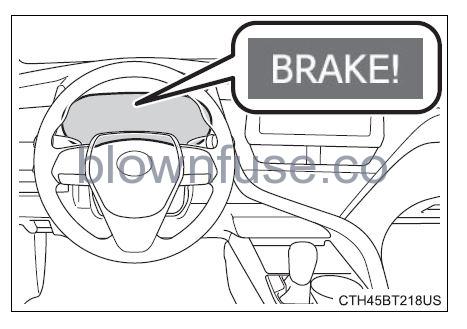
When the system determines that the possibility of a frontal collision is high, a buzzer will sound and a warning message will be displayed on the multi-information display to urge the driver to take evasive action.
Pre-collision brake assist
When the system determines that the possibility of a frontal collision is high, the system applies greater braking force in relation to how strongly the brake pedal is depressed.
Pre-collision braking
If the system determines that the possibility of a frontal collision is extremely high, the brakes are automatically applied to help avoid the collision or reduce the impact of the collision.
Emergency steering assist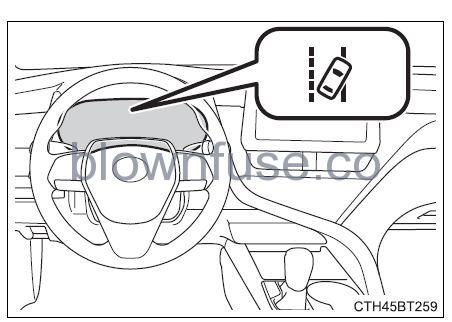
If the system determines that the possibility of a frontal collision is high and that there is sufficient space for the vehicle to be steered into within its lane, and the driver has begun evasive maneuver or steering, emergency steering assistance will assist the steering movements to help enhance the vehicle stability and for lane departure prevention. During operation, the indicator will illuminate in green.
Intersection right/left turn assistance
If the system determines that there is a high possibility of a collision in the following situations, it will assist with Pre-collision warning and, if necessary Pre-collision braking.
Depending on the configuration of the intersection, it may not be possible to support.
- When you turn right/left at an intersection and cross the path of an oncoming vehicle
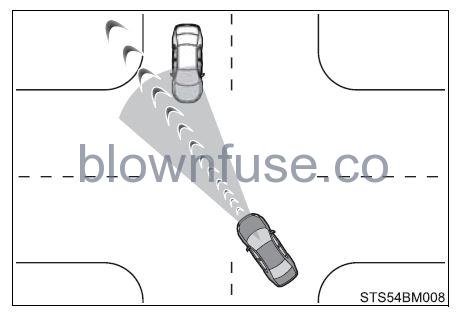
- When you turn right/left, a pedestrian is detected in the forward direction and estimated to enter your vehicle’s path (bicyclists are not detected.)
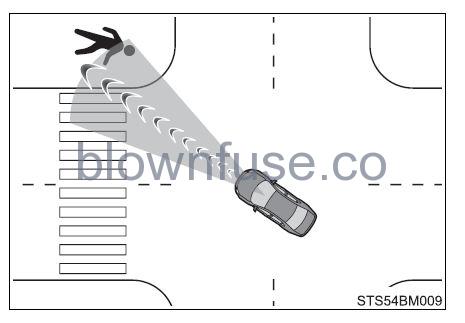
WARNING
- Limitations of the pre-collision system
- The driver is solely responsible for safe driving. Always drive safely, taking care to observe your surroundings.
- Do not use the pre-collision system instead of normal braking operations under any circumstances. This system will not prevent collisions or lessen collision damage or injury in every situation. Do not overly rely on this system. Failure to do so may lead to an accident, resulting in death or serious injury.
- Although this system is designed to help avoid a collision or help reduce the impact of the collision, its effectiveness may change according to various conditions, therefore the system may not always be able to achieve the same level of performance. Read the following conditions carefully. Do not overly rely on this system and always drive carefully.
- Do not attempt to test the operation of the pre-collision system yourself. Depending on the objects used for testing (dummies, cardboard objects imitating detectable objects, etc.), the system may not operate properly, possibly leading to an accident.
- The driver is solely responsible for safe driving. Always drive safely, taking care to observe your surroundings.
WARNING
Pre-collision braking
- When the pre-collision braking function is operating, a large amount of braking force will be applied.
- If the vehicle is stopped by the operation of the pre-collision braking function, the pre-collision braking function operation will be canceled after approximately 2 seconds. Depress the brake pedal as necessary.
- The pre-collision braking function may not operate if certain operations are performed by the driver. If the accelerator pedal is being depressed strongly or the steering wheel is being turned, the system may determine that the driver is taking evasive action and possibly prevent the pre-collision braking function from operating.
- In some situations, while the pre-collision braking function is operating, operation of the function may be canceled if the accelerator pedal is depressed strongly or the steering wheel is turned and the system determines that the driver is taking evasive action.
- If the brake pedal is being depressed, the system may determine that the driver is taking evasive action and possibly delay the operation timing of the pre-collision braking function.
Emergency steering assist
- An emergency steering assist operation will be canceled when the system determines that the lane departure prevention function has been completed.
- Emergency steering assist may not operate or may be canceled in the following cases as the system may determine the driver is taking action.
- If the accelerator pedal is being depressed strongly, the steering wheel is being operated sharply, the brake pedal is being depressed or the turn signal lever is being operated. In this case, the system may determine that the driver is taking evasive action and the emergency steering assist may not operate.
- In some situations, while the emergency steering assist is operating, the operation of the function may be canceled if the accelerator pedal is depressed strongly, the steering wheel is operated sharply or the brake pedal is being depressed and the system determines that the driver is taking evasive action.
- When the emergency steering assist is operating, if the steering wheel is held firmly or is operated in the opposite direction to that which the system is generating torque, the function may be canceled.
When to disable the pre-collision system
In the following situations, disable the system, as it may not operate properly, possibly leading to an accident resulting in death or serious injury:
- When the vehicle is being towed
- When your vehicle is towing another vehicle
- When transporting the vehicle via truck, boat, train, or similar means of transportation
- When the vehicle is raised on a lift with the engine running and the tires are allowed to rotate freely
- When inspecting the vehicle using a drum tester such as a chassis dynamometer or speedometer tester, or when using an on vehicle wheel balancer
- When a strong impact is applied to the front bumper or front grille, due to an accident or other reasons
- If the vehicle cannot be driven in a stable manner, such as when the vehicle has been in an accident or is malfunctioning
- When the vehicle is driven in a sporty manner or off-road
- When the tires are not properly inflated
- When the tires are very worn
- When tires of a size other than specified are installed
- When tire chains are installed
- When a compact spare tire or an emergency tire puncture repair kit is used
- If equipment (snowplow, etc.) that may obstruct the radar sensor or front camera is temporarily installed in the vehicle
Changing settings of the pre-collision system
Enabling/disabling the pre-collision system
The pre-collision system can be enabled/disabled on  (4.2-inch display) or
(4.2-inch display) or  (7-inch display) (P. 103, 117) of the multi-information display Vehicles without a smart key system: The system is automatically enabled each time the engine switch is turned to the “ON” position. Vehicles with a smart key system: The system is automatically enabled each time the engine switch is turned to IGNITION ON mode. If the system is disabled, the PCS warning light will turn on and a message will be displayed on the multi-information display.
(7-inch display) (P. 103, 117) of the multi-information display Vehicles without a smart key system: The system is automatically enabled each time the engine switch is turned to the “ON” position. Vehicles with a smart key system: The system is automatically enabled each time the engine switch is turned to IGNITION ON mode. If the system is disabled, the PCS warning light will turn on and a message will be displayed on the multi-information display.
Changing the pre-collision warning timing
The pre-collision warning timing can be changed on  (4.2-inch display) or
(4.2-inch display) or  (7-inch display) (P. 103, 117) of the multi-information display The warning timing setting is retained when the engine switch is turned off. However, if the pre-collision system is disabled and re-enabled, the operation timing will return to the default setting (middle). If the pre-collision warning timing is changed, emergency steering assist timing will also be changed accordingly. If late is selected, emergency steering assist would not operate in case of an emergency.
(7-inch display) (P. 103, 117) of the multi-information display The warning timing setting is retained when the engine switch is turned off. However, if the pre-collision system is disabled and re-enabled, the operation timing will return to the default setting (middle). If the pre-collision warning timing is changed, emergency steering assist timing will also be changed accordingly. If late is selected, emergency steering assist would not operate in case of an emergency.
- Early
- Middle
- This is the default setting.
- Late
Operational conditions for each pre-collision function
The pre-collision system is enabled and the system determines that the possibility of a frontal collision with a detected object is high. The system may not operate in the following situations:
- If a battery terminal has been disconnected and reconnected and then the vehicle has not been driven for a certain amount of time
- If the shift lever is in R
- When the VSC OFF indicator is illuminated (only the pre-collision warning function will be operational)
The operation speeds and operation cancellation for each function are listed below.
Pre-collision warning
|
Detectable objects |
Vehicle speed |
Relative speed between your vehicle and object |
| Preceding and stopped vehicles | Approx. 7 to 110 mph (10 to
180 km/h) |
Approx. 7 to 110 mph
(10 to 180 km/h) |
| Oncoming vehi- cles | Approx. 7 to 110 mph (10 to
180 km/h) |
Approx. 13 to 110
mph (20 to 180 km/h) |
| Bicyclists and pedestrians | Approx. 7 to 50 mph (10 to
80 km/h) |
Approx. 7 to 50 mph
(10 to 80 km/h) |
Pre-collision brake assist
|
Detectable objects |
Vehicle speed |
Relative speed between your vehicle and object |
| Preceding and stopped vehicles | Approx. 20 to 110 mph (30
to 180 km/h) |
Approx. 20 to 110
mph (30 to 180 km/h) |
| Bicyclists and pedestrians | Approx. 20 to 50 mph (30 to
80 km/h) |
Approx. 20 to 50 mph
(30 to 80 km/h) |
Pre-collision braking
If either of the following occurs while the pre-collision braking function is operating, it will be canceled:
- The accelerator pedal is depressed strongly.
- The steering wheel is turned sharply or abruptly.
Emergency steering assist
When the turn signal lights are flashing, emergency steering assist will not operate in case of an emergency.
|
Detectable objects |
Vehicle speed |
Relative speed between your vehicle and object |
| Preceding and stopped vehicles, bicyclists and pedestrians |
Approx. 25 to 50 mph (40 to 80 km/h) |
Approx. 25 to 50 mph (40 to 80 km/h) |
If any of the following occurs while the emergency steering assist function is operating, it will be canceled:
- The accelerator pedal is depressed strongly.
- The steering wheel is turned sharply or abruptly.
- The brake pedal is depressed.
Intersection right/left turn assistance (pre-collision warning)
| Detectable objects |
Vehicle speed |
Oncoming vehi- cle speed | Relative speed between your vehicle and object | ||
| Oncoming vehicles | Approx. 7
mph (10 km/h) |
to to | 15
25 |
Approx. 20 to 35
mph (30 to 55 km/h) |
Approx. 25 to 50
mph (40 to 80 km/h) |
| Approx. 7 | to | 15 | Approx. 7 to 15 | ||
| Pedestrians | mph (10 km/h) | to | 25 | ¾ | mph (10 to 25 km/h) |
When the turn signal lights are not flashing, support for turning left or right at an intersection that targets oncoming vehicles does not work.
Intersection right/left turn assistance (pre-collision braking)
| Detectable objects |
Vehicle speed |
Oncoming vehi- cle speed | Relative speed between your vehicle and object |
| Oncoming vehicles | Approx. 10 to 15
mph (15 to 25 km/h) |
Approx. 20 to 28
mph (30 to 45 km/h) |
Approx. 28 to 43
mph (45 to 70 km/h) |
|
Pedestrians |
Approx. 7 to 15
mph (10 to 25 km/h) |
¾ |
Approx. 7 to 15
mph (10 to 25 km/h) |
When the turn signal lights are not flashing, support for turning left or right at an intersection that targets oncoming vehicles does not work.
Object detection function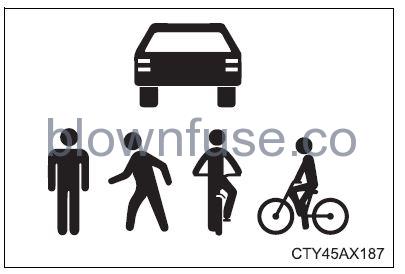
The system detects objects based on their size, profile, motion, etc. However, an object may not be detected depending on the surrounding brightness and the motion, posture, and angle of the detected object, preventing the system from operating properly. (P. 266) The illustration shows an image of detectable objects.
Conditions under which the system may operate even if there is no possibility of a collision
● In some situations such as the following, the system may determine that there is a possibility of a frontal collision and operate.
- When passing a detectable object, etc.
- When changing lanes while overtaking a detectable object, etc.
- When approaching a detectable object in an adjacent lane or on the roadside, such as when changing the course of travel or driving on a winding road

- When rapidly closing on a detectable object, etc.
- When approaching objects on the roadside, such as detectable objects, guardrails, utility poles, trees, or walls
- When there is a detectable object or other object by the roadside at the entrance of a curve
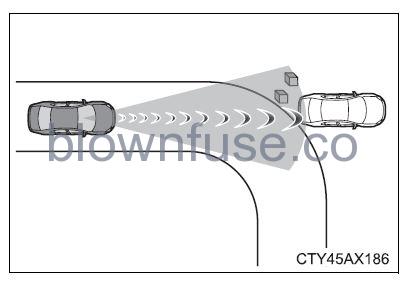
- When there are patterns or paint in front of your vehicle that may be mistaken for a detectable object
- When the front of your vehicle is hit by water, snow, dust, etc.
- When overtaking a detectable object that is changing lanes or making a right/left turn

- When passing a detectable object in an oncoming lane that is stopped to make a right/left turn

- When a detectable object approaches very close and then stops before entering the path of your vehicle
- If the front of your vehicle is raised or lowered, such as when on an uneven or undulating road surface
- When driving on a road surrounded by a structure, such as in a tunnel or on an iron bridge
- When there is a metal object (manhole cover, steel plate, etc.), steps, or a protrusion in front of your vehicle
- When passing under an object (road sign, billboard, etc.)
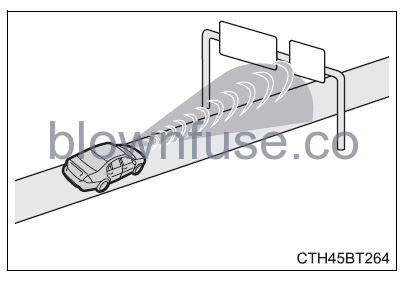
- When approaching an electric toll gate barrier, parking area barrier, or another barrier that opens and closes
- When using an automatic car wash
- When driving through or under objects that may contact your vehicles, such as thick grass, tree branches, or a banner
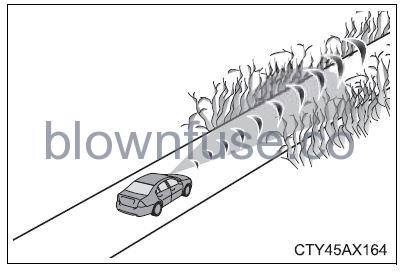
- When driving through steam or smoke
- When driving near an object that reflects radio waves, such as a large truck or guardrail
- When driving near a TV tower, broadcasting station, electric power plant, radar-equipped vehicles, etc., or other location where strong radio waves or electrical noise may be present
- When there are many things that can reflect the radio waves of the radar in the vicinity (tunnels, truss bridges, gravel roads, the snow-covered roads that have tracks, etc.)
- While making a right/left turn, when an oncoming vehicle or a crossing pedestrian has already exited the path of your vehicle
- While making a right/left turn, closely in front of an oncoming vehicle or a crossing pedestrian.
- While making a right/left turn, when an oncoming vehicle or a crossing pedestrian stops before entering the path of your vehicle
- While making a right/left turn, when an oncoming vehicle turns right/left in front of your vehicle
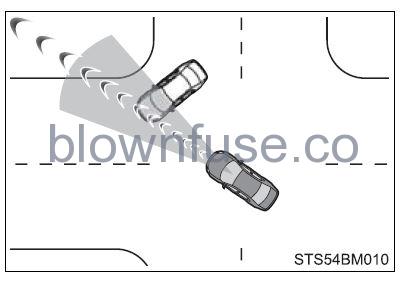
- While steering in the direction of oncoming traffic
Situations in which the system may not operate properly
In some situations such as the following, an object may not be detected by the radar sensor and front camera, preventing the system from operating properly:
- When a detectable object is approaching your vehicle
- When your vehicle or a detectable object is wobbling
- If a detectable object makes an abrupt maneuver (such as sudden swerving, acceleration, or deceleration)
- When your vehicle approaches a detectable object rapidly
- When a detectable object is not directly in front of your vehicle
- When a detectable object is near a wall, fence, guardrail, manhole cover, vehicle, steel plate on the road, etc.
- When a detectable object is under a structure
- When part of a detectable object is hidden by an object, such as large baggage, an umbrella, or a guardrail
- When there are many things that can reflect the radio waves of the radar in the vicinity (tunnels, truss bridges, gravel roads, the snow-covered roads that have tracks, etc.)
- When there is an effect on the radio waves to the radar that is installed on another vehicle
- When multiple detectable objects are close together
- If the sun or other light is shining directly on a detectable object
- When a detectable object is a shade of white and looks extremely bright
- When a detectable object appears to be nearly the same color or brightness as its surroundings
- If a detectable object cuts or suddenly emerges in front of your vehicle
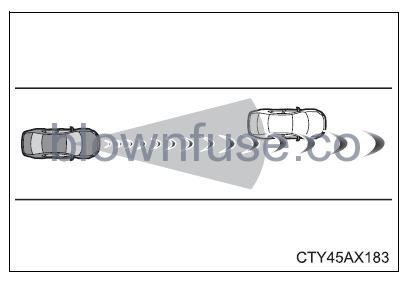
- When the front of your vehicle is hit by water, snow, dust, etc.
- When a very bright light ahead, such as the sun or the headlights of oncoming traffic, shines directly into the front camera
- When approaching the side or front of a vehicle ahead
- If a vehicle ahead is a motorcycle
- If a vehicle ahead is narrow, such as a personal mobility vehicle
- If a preceding vehicle has a small rear end, such as an unloaded truck
- If a preceding vehicle has a low rear end, such as a low bed trailer
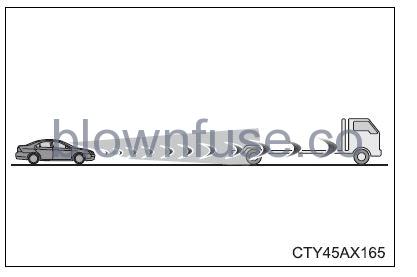
- If a vehicle ahead has an extremely high ground clearance
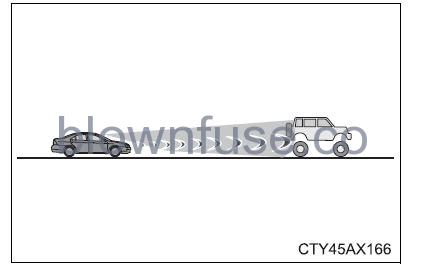
- If a vehicle ahead is carrying a load that protrudes past its rear bumper
- If a vehicle ahead is irregularly shaped, such as a tractor or sidecar
- If a vehicle ahead is a child-sized bicycle, a bicycle that is carrying a large load, a bicycle ridden by more than one person, or a uniquely shaped bicycle (bicycle with a child seat, tandem bicycle, etc.)
- If a pedestrian/ or the riding height of a bicyclist ahead is shorter than approximately 3.2 ft. (1 m) or taller than approximately 6.5 ft. (2 m)
- If a pedestrian/bicyclist is wearing oversized clothing (a raincoat, long skirt, etc.), making their silhouette obscure
- If a pedestrian is bending forward or squatting or a bicyclist is bending for-ward
- If a pedestrian/bicyclist is moving fast
- If a pedestrian is pushing a stroller, wheelchair, bicycle, or another vehicle
- When driving in inclement weather such as heavy rain, fog, snow, or a sandstorm
- When driving through steam or smoke
- When the surrounding area is dim, such as at dawn or dusk, or while at night or in a tunnel, making a detectable object appear to be nearly the same color as its surroundings
- When driving in a place where the surrounding brightness changes suddenly, such as at the entrance or exit of a tunnel
- After the engine has started the vehicle has not been driven for a certain amount of time
- While making a left/right turn and for a few seconds after making a left/right turn
- While driving on a curve and for a few seconds after driving on a curve
- If your vehicle is skidding
- If the front of the vehicle is raised or lowered
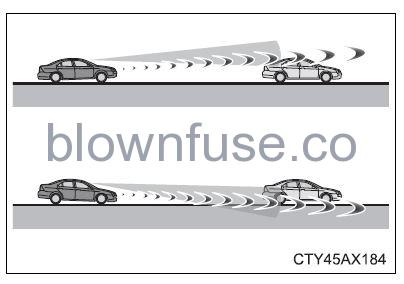
- If the wheels are misaligned
- If a wiper blade is blocking the front camera
- The vehicle is being driven at extremely high speeds
- When driving on a hill
- If the radar sensor or front camera is misaligned
- When driving in a traffic lane separated by more than one lane where oncoming vehicles are driving while making a right/left turn
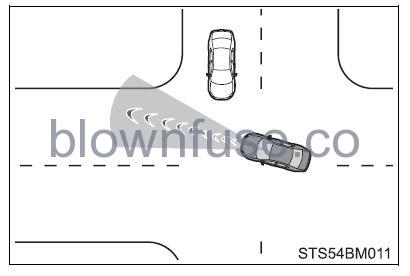
- When largely out of place with the opposite facing targeted oncoming vehicle during a right/left turn
- While making a right/left turn, when a pedestrian approaches from behind or side of your vehicle
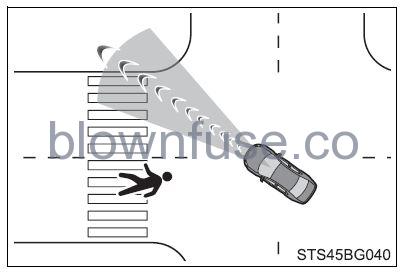
In addition to the above, in some situations, such as the following, the emergency steering assist may not operate.
- When the white (yellow) lane lines are difficult to see, such as when they are faint, diverging/merging, or a shadow is cast upon them
- When the lane is wider or narrower than normal
- When there is a light and dark pattern on the road surface, such as due to road repairs
- When the target is too close
- When there is insufficient safe or unobstructed space for the vehicle to be steered into
- If an oncoming vehicle is present
- If the VSC function is operating
In some situations such as the following, sufficient braking force or steering force may not be obtained, preventing the system from performing properly:
- If the braking functions cannot operate to their full extent, such as when the brake parts are extremely cold, extremely hot, or wet
- If the vehicle is not properly maintained (brakes or tires are excessively worn, improper tire inflation pressure, etc.)
- When the vehicle is being driven on a gravel road or other slippery surface
- When the road surface has deep wheel tracks
- When driving on a hill road
- When driving on a road that has inclined to the left or right
If VSC is disabled
- If VSC is disabled (P. 324), the pre-collision brake assist and pre-collision braking functions are also disabled.
- The PCS warning light will turn on and “VSC Turned Off Pre-Collision Brake System Unavailable” will be displayed on the multi-information display.
LTA (Lane Tracing Assist)
Summary of functions
While driving on a road with clear white (yellow) lane lines, the LTA system warns the driver of the vehicle may deviate from the current lane of course*, and also can slightly operate the steering wheel to help avoid deviation from the lane or course*. Also, while the dynamic radar cruise control with full-speed range or dynamic radar cruise control is operating, this system will operate the steering wheel to maintain the vehicle’s lane position. The LTA system recognizes white (yellow) lane lines or a course* using the front camera. Additionally, it detects preceding vehicles using the front camera and radar.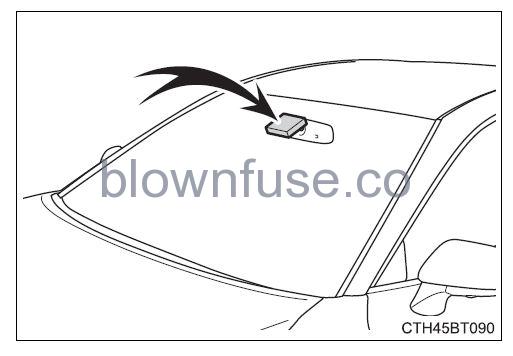
The boundary between asphalt and the side of the road, such as grass, soil, or a curb
WARNING
- Before using the LTA system
- Do not rely solely upon the LTA system. The LTA system does not automatically drive the vehicle or reduce the amount of attention that must be paid to the area in front of the vehicle. The driver must always assume full responsibility for driving safely by paying careful attention to the surrounding conditions and operating the steering wheel to correct the path of the vehicle. Also, the driver must take adequate breaks when fatigued, such as from driving for a long period of time.
- Failure to perform appropriate driving operations and pay careful attention may lead to an accident, resulting in death or serious injury.
WARNING
- Situations unsuitable for the LTA system
In the following situations, use the LTA switch to turn the system off. Failure to do so may lead to an accident, resulting in death or serious injury.- The vehicle is driven on a road surface that is slippery due to rainy weather, fallen snow, freezing, etc.
- The vehicle is driven on a snow-covered road.
- White (yellow) lines are difficult to see due to rain, snow, fog, dust, etc.
- The vehicle is driven in a temporary lane or restricted lane due to construction work.
- The vehicle is driven in a construction zone.
- A spare tire, tire chains, etc. are equipped.
- When the tires have been excessively worn, or when the tire inflation pressure is low.
- During emergency towing
- Preventing LTA system malfunctions and operations performed by mistake
- Do not modify the headlights or place stickers, etc. on the surface of the lights.
- Do not modify the suspension etc. If the suspension etc. needs to be replaced, contact your Toyota dealer.
- Do not install or place anything on the hood or grille. Also, do not install a grille guard (bull bars, kangaroo bar, etc.).
- If your windshield needs repairs, contact your Toyota dealer.
WARNING
- Conditions in which functions may not operate properly
- In the following situations, the functions may not operate properly and the vehicle may depart from its lane. Drive safely by always paying careful attention to your surroundings and operating the steering wheel to correct the path of the vehicle without relying solely on the functions.
- When the follow-up cruising display is displayed (P. 280) and the preceding vehicle changes lanes. (Your vehicle may follow the preceding vehicle and also change lanes.)
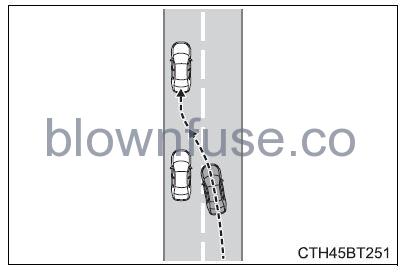
- When the follow-up cruising display is displayed (P. 280) and the preceding vehicle is swaying. (Your vehicle may sway accordingly and depart from the lane.)
- When the follow-up cruising display is displayed (P. 280) and the preceding vehicle departs from its lane. (Your vehicle may follow the preceding vehicle and depart from the lane.)
- When the follow-up cruising display is displayed (P. 280) and the preceding vehicle is being driven extremely close to the left/right lane line. (Your vehicle may follow the preceding vehicle and depart from the lane.)
- The vehicle is being driven around a sharp curve.
- Objects or patterns that could be mis- taken for white (yellow) lines are pres- ent on the side of the road (guardrails, reflective poles, etc.).

WARNING
- The vehicle is driven where the road diverges, merges, etc.
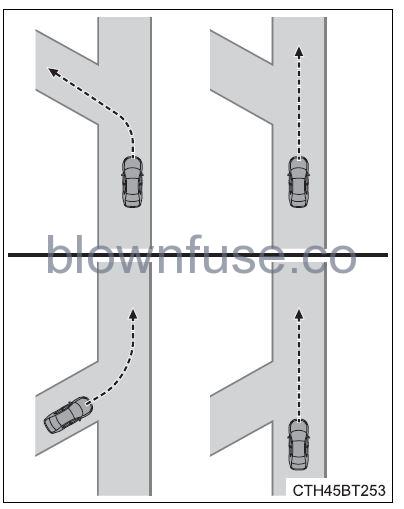
- Repair marks of asphalt, white (yellow) lines, etc. are present due to road repair.
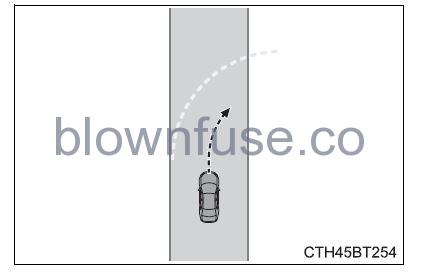
- There are shadows on the road that runs parallel with, or cover, the white (yellow) lines.
- The vehicle is driven in an area without white (yellow) lines, such as in front of a tollgate or checkpoint, at an intersection, etc.
- The white (yellow) lines are cracked, “Botts’ dots”, “Raised pavement marker” or stones are present.
- The white (yellow) lines cannot be seen or are difficult to see due to sand, etc.
- The vehicle is driven on a road surface that is wet due to rain, puddles, etc.
- The traffic lines are yellow (which may be more difficult to recognize than lines that are white).
- The white (yellow) lines cross over a curb, etc.
- The vehicle is driven on a bright surface, such as concrete.
- If the edge of the road is not clear or straight.
- The vehicle is driven on a surface that is bright due to reflected light, etc.
- The vehicle is driven in an area where the brightness changes suddenly, such as at the entrances and exits of tunnels, etc.
WARNING
- Light from the headlights of an oncoming vehicle, the sun, etc. enters the camera.
- The vehicle is driven on a slope.
- The vehicle is driven on a road that tilts left or right or a winding road.
- The vehicle is driven on an unpaved or rough road.
- The traffic lane is excessively narrow or wide.
- The vehicle is extremely tilted due to carrying heavy luggage or having improper tire pressure.
- The distance to the preceding vehicle is extremely short.
- The vehicle is moving up and down a large amount due to road conditions during driving (poor roads or road seams).
- When driving in a tunnel or at night with the headlights off or when a headlight is dim due to its lens being dirty or it is misaligned.
- The vehicle is struck by a crosswind.
- The vehicle is affected by wind from a vehicle driven in a nearby lane.
- The vehicle has just changed lanes or crossed an intersection.
- Tires that differ by structure, manufacturer, brand, or tread pattern are used.
- When tires of a size other than specified are installed.
- Snow tires, etc. are equipped.
- The vehicle is being driven at extremely high speeds.
Functions included in the LTA system
Lane departure alert function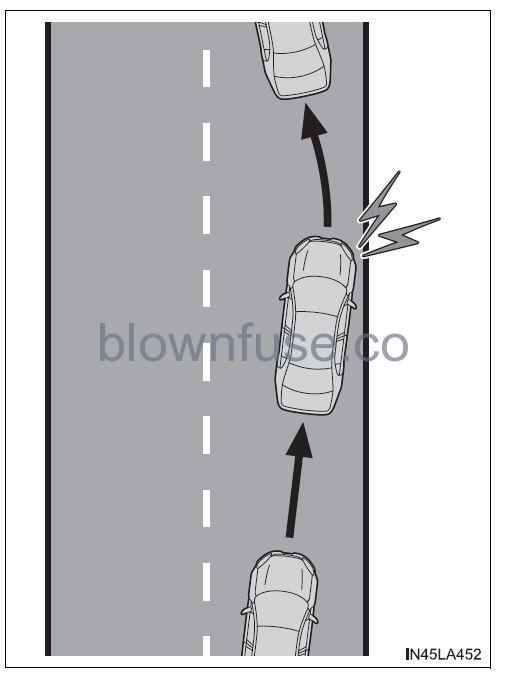
When the system determines that the vehicle might depart from its lane or course*, a warning is displayed on the multi-information display, and a warning buzzer will sound to alert the driver. When the warning buzzer sounds, check the area around your vehicle and carefully operate the steering wheel to move the vehicle back to the center of the lane.
A vehicle with BSM: When the system determines that the vehicle might depart from its lane and that the possibility of a collision with an overtaking vehicle in the adjacent lane is high, the lane departure alert will operate even if the turn signals are operating.
The boundary between asphalt and the side of the road, such as grass, soil, or a curb
Steering assist function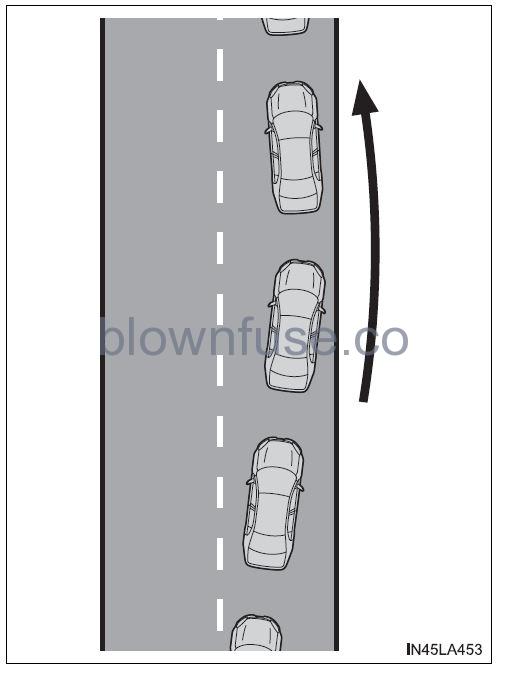
When the system determines that the vehicle might depart from its lane or course*, the system provides assistance as necessary by operating the steering wheel in small amounts for a short period of time to keep the vehicle in its lane. A vehicle with BSM: When the system determines that the vehicle might depart from its lane and that the possibility of a collision with an overtaking vehicle in the adjacent lane is high, the steering assist function will operate even if the turn signals are operating.
The boundary between asphalt and the side of the road, such as grass, soil, or a curb
Vehicle sway warning function
When the vehicle is swaying within a lane, the warning buzzer will sound and a message will be displayed on the multi-information display to alert the driver.
Lane centering function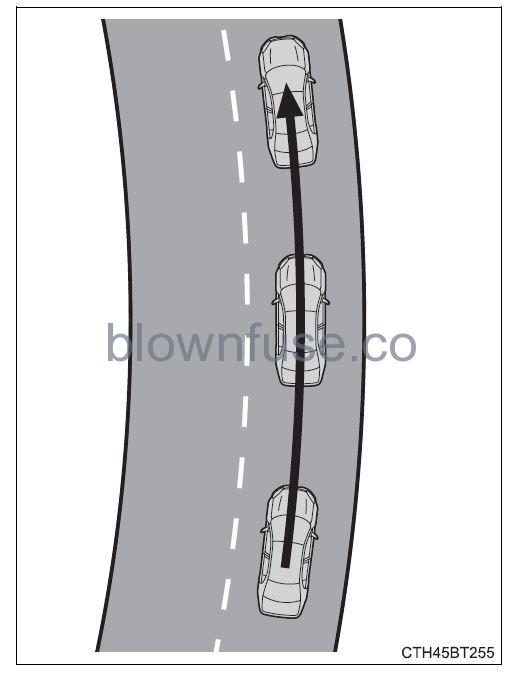
This function is linked with dynamic radar cruise control with full-speed range or dynamic radar cruise control and provides the required assistance by operating the steering wheel to keep the vehicle in its current lane. When dynamic radar cruise control with full-speed range or dynamic radar cruise control is not operating, the lane centering function does not operate. In situations where the white (yellow) lane lines are difficult to see or are not visible, such as when in a traffic jam, this function will operate to help follow a preceding vehicle by monitoring the position of the preceding vehicle.
Turning the LTA system on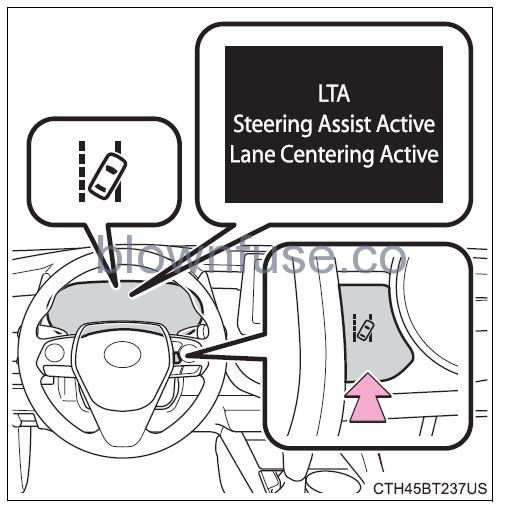
Press the LTA switch to turn the LTA system on. The LTA indicator illuminates and a message is displayed on the multi-information display. Press the LTA switch again to turn the LTA system off. When the LTA system is turned on or off, the operation of the LTA system continues in the same condition the next time the engine is started.
Indications on the multi-information display
The illustration used is intended as an example and may differ from the image that is actually displayed on the multi-information display.
- LTA indicator
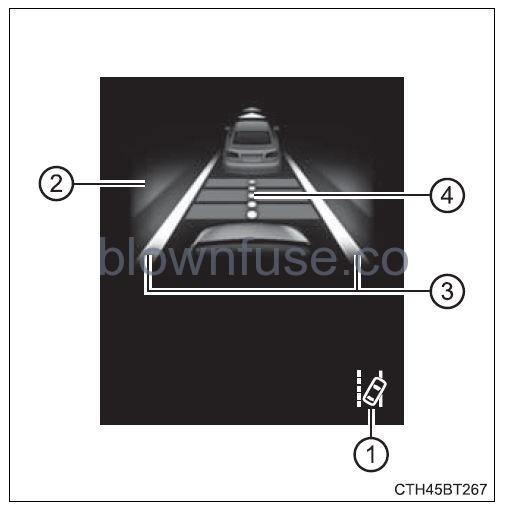
The illumination condition of the indicator informs the driver of the system’s operation status.- Illuminated in white:
- LTA system is operating.
- Illuminated in green:
- Steering wheel assistance of the steering assist function or lane centering function is operating.
- Flashing in yellow:
- The lane departure alert function is operating.
- Illuminated in white:
- Operation display of steering wheel operation support
- Displayed when the multi-information display is switched to the driving assist system information display.
- Indicates that steering wheel assistance of the steering assist function or lane centering function is operating.
- Both outer sides of the lane are displayed: Indicating that the steering wheel assist of the lane centering function is operating.
- One outer side of the lane is displayed: Indicating that the steering wheel assist of the steering assist function is operating.
- Both outer sides of the lane are flashing: Alerts the driver that their input is necessary to stay in the center of the lane (lane centering function).
- Lane departure alert function display
- Displayed when the multi-information display is switched to the driving assist system information display.
- Inside of displayed lines is white
- Inside of displayed lines in black

- Indicates that the system is recognizing white (yellow) lines or a course*. When the vehicle departs from its lane, the white line displayed on the side the vehicle departs from flashes yellow.
- Indicates that the system is not able to recognize white (yellow) lines or a course* or is temporarily canceled.
- Displayed when the multi-information display is switched to the driving assist system information display.
- The boundary between asphalt and the side of the road, such as grass, soil, or a curb
- Follow-up cruising display
- Displayed when the multi-information display is switched to the driving assist system information display.
- Indicates that the steering assist of the lane centering function is operating by monitoring the position of a preceding vehicle.
- When the follow-up cruising display is displayed, if the preceding vehicle moves, your vehicle may move in the same way. Always pay careful attention to your surroundings and operate the steering wheel as necessary to correct the path of the vehicle and ensure safety.
- Displayed when the multi-information display is switched to the driving assist system information display.
Operation conditions of each function
Lane departure alert function This function operates when all of the following conditions are met.
- LTA is turned on.
- Vehicle speed is approximately 32 mph (50 km/h) or more.*1
- The system recognizes white (yellow) lane lines or a course*2. (When a white [yellow] line or course*2 is recognized on only one side, the system will operate only for the recognized side.)
- The width of the traffic lane is approximately 9.8 ft. (3 m) or more.
- Turn signal lever is not operated. (Vehicle with BSM: Except when another vehicle is in the lane on the side where the turn signal was operated)
- The vehicle is not being driven around a sharp curve.
- No system malfunctions are detected. (P. 284)
- The function operates even if the vehicle speed is less than approximately 32 mph (50 km/h) when the lane centering function is operating.
- The boundary between asphalt and the side of the road, such as grass, soil, or a curb
- Steering assist function This function operates when all of the following conditions are met in addition to the operating conditions for the lane departure alert function.
- The vehicle is not accelerated or decelerated by a fixed amount or more.
- The steering wheel is not operated with a steering force level suitable for changing lanes.
- ABS, VSC, TRAC, and PCS are not operating.
- TRAC or VSC is not turned off.
- Vehicle sway warning function
- This function operates when all of the following conditions are met.
- Setting for “Sway Warning” in
 (4.2-inch display) or
(4.2-inch display) or  (7-inch display) of the multi-information display is set to “On”. (P. 98, 111)
(7-inch display) of the multi-information display is set to “On”. (P. 98, 111) - Vehicle speed is approximately 32 mph (50 km/h) or more.
- The width of the traffic lane is approximately 9.8 ft. (3 m) or more.
- No system malfunctions are detected. (P. 284)
- Setting for “Sway Warning” in
- This function operates when all of the following conditions are met.
- Lane centering function
- This function operates when all of the following conditions are met.
- LTA is turned on.
- Setting for “Lane Center” in
 (4.2-inch display) or
(4.2-inch display) or  (7-inch display) of the multi-information display is set to “On”. (P. 98, 111)
(7-inch display) of the multi-information display is set to “On”. (P. 98, 111) - This function recognizes white (yellow) lane lines or the position of a preceding vehicle (except when the preceding vehicle is small, such as a motorcycle).
- The dynamic radar cruise control with full-speed range or dynamic radar cruise control is operating in vehicle-to-vehicle distance control mode.
- The width of the traffic lane is approximately 10 to 13 ft. (3 to 4 m).
- The turn signal lever is not operated.
- The vehicle is not being driven around a sharp curve.
- No system malfunctions are detected. (P. 284)
- The vehicle does not accelerate or decelerate by a fixed amount or more.
- The steering wheel is not operated with a steering force level suitable for changing lanes.
- ABS, VSC, TRAC, and PCS are not operating.
- TRAC or VSC is not turned off.
- Hands-off steering wheel warnings are not displayed. (P. 283)
- The vehicle is being driven in the center of a lane.
- The steering assist function is not operating.
- Temporary cancelation of functions
- When operation conditions are no longer met, a function may be temporarily canceled. However, when the operating conditions are met again, the operation of the function is automatically restored. (P. 281)
- If the operation conditions (P. 281) are no longer met while the lane centering function is operating, the buzzer may sound to indicate that the function has been temporarily canceled.
- Steering assist function/lane centering function
- Depending on the vehicle speed, lane departure situation, road conditions, etc., the driver may not feel the function is operating or the function may not operate at all.
- The steering control of the function is overridden by the driver’s steering wheel operation.
- Do not attempt to test the operation of the steering assist function.
- Lane departure alert function
- The warning buzzer may be difficult to hear due to external noise, audio playback, etc.
- If the edge of the course* is not clear or straight, the lane departure alert function may not operate.
- A vehicle with BSM: It may not be possible for the system to determine if there is a danger of a collision with a vehicle in an adjacent lane.
- Do not attempt to test the operation of the lane departure alert function.
The boundary between asphalt and the side of the road, such as grass, soil, or a curb
Hands off steering wheel warning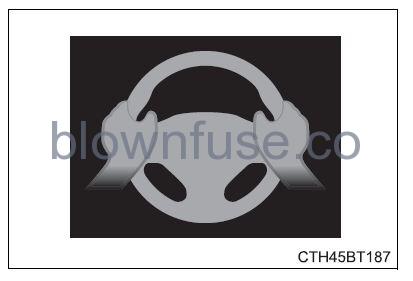
In the following situations, a warning message urging the driver to hold the steering wheel and the symbol is shown in the illustration are displayed on the multi-information display to warn the driver. The warning stops when the system determines that the driver holds the steering wheel. Always keep your hands on the steering wheel when using this system, regardless of warnings.
- When the system determines the driver is not holding the steering wheel while the lane centering function is operating.
- If the driver continues to keep their hands off of the steering wheel, the buzzer sounds, the driver is warned and the function is temporarily canceled. This warning also operates in the same way when the driver continuously operates the steering wheel for only a small amount.
- When the system determines that the vehicle may deviate from the lane while driving around a curve while the lane centering function is operating.
- Depending on the vehicle condition and road conditions, the warning may not operate. Also, if the system determines that the vehicle is driving around a curve, warnings will occur earlier than during straight-line driving.
- When the system determines that the driver is driving without holding the steering wheel while the steering wheel assist of the steering assist function is operating.
- If the driver continues to keep their hands off of the steering wheel and the steering wheel assist is operating, the buzzer sounds, and the driver is warned. Each time the buzzer sounds, the continuing time of the buzzer becomes longer.
Vehicle sway warning function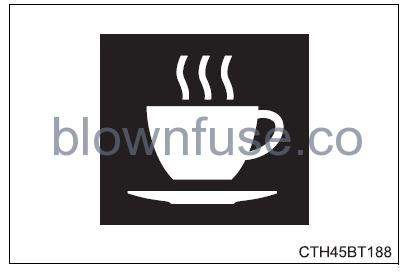
When the system determines that the vehicle is swaying while the vehicle sway warning function is operating, a buzzer sounds and a warning message urging the driver to rest and the symbol shown in the illustration are simultaneously displayed on the multi-information display. Depending on the vehicle and road conditions, the warning may not operate.
Warning message
If the following warning message is displayed on the multi-information display and the LTA indicator illuminates in yellow, follow the appropriate troubleshooting procedure. Also, if a different warning message is displayed, follow the instructions displayed on the screen.
- LTA Malfunction Visit Your Dealer
- The system may not be operating properly. Has the vehicle been inspected by your Toyota dealer?
- “LTA Unavailable”
- The system is temporarily canceled due to a malfunction in a sensor other than the front camera. Turn the LTA system off, wait for a little while, and then turn the LTA system back on.
- “LTA Unavailable at Current Speed”
- The function cannot be used as the vehicle speed exceeds the LTA operation range. Drive slower.
Customization
Function settings can be changed. (P. 103, 117)
RSA (Road Sign Assist)
Summary of function
The RSA system recognizes specific road signs using the front camera and/or navigation system (when speed limit information is available) to provide information to the driver via the display. If the system judges that the vehicle is being driven over the speed limit, performing prohibited actions, etc. according to the recognized road signs, it notifies the driver through a visual notification and notification buzzer. This setting needs to be customized.
WARNING
Before using the RSA Do not rely solely upon the RSA system. RSA is a system that supports the driver by providing information, but it is not a replacement for a driver’s own vision and awareness. Drive safely by always paying careful attention to the traffic rules.
Indication of the multi-information display
When the front camera recognizes a sign and/or information about a sign is available from the navigation system, the sign will be displayed on the multi-information display.
- When the driving assist system information is selected, a maximum of 3 signs can be displayed. (P. 98, 111)

- When a tab other than the driving assist system information is selected, the following types of road signs will be displayed (P. 98, 111)
- Speed limit sign
- Do Not Enter sign (when notification is necessary)
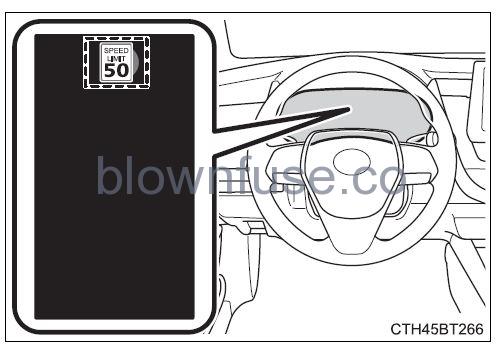
- If signs other than speed limit signs are recognized, they will be displayed in an overlapping stack under the current speed limit sign.
Supported types of road signs
The following types of road signs, including electronic signs and blink-ing signs, are recognized. A nonofficial or a recently introduced traffic sign may not be recognized.
| Type | Multi-information display |
|
Speed limit |
|
|
Do Not Enter |
|
|
Stop |
|
|
Yield |
Notification function
In the following situations, the RSA system will notify the driver.
- When the vehicle speed exceeds the speed notification threshold of the speed limit sign displayed, the sign display will be emphasized and a buzzer will sound.
- When the RSA system recognizes a do not enter sign and deter-mines that your vehicle has entered a no-entry area, the displayed sign will flash and a buzzer will sound.
Depending on the situation, a notification function may not operate properly.
Setting procedure
- Vehicles with 4.2-inch multi-information display
- Press
 of the meter control switches, select
of the meter control switches, select  .
. - Press </> of the meter control switches, select
 .
. - Press
 the meter control switch.
the meter control switch. - Each time
 is pressed, the function changes on/off.
is pressed, the function changes on/off.
- Press
- Vehicles with 7-inch multi-information display
- Press
 of the meter control switches, select
of the meter control switches, select  .
. - Press </> of the meter control switches, select
 .
. - Press
 of the meter control switch.
of the meter control switch. - Each time
 is pressed, the function changes on/off
is pressed, the function changes on/off
- Press
Automatic turn-off of RSA sign display
In the following situations, a displayed speed limit sign and/or do not enter sign will stop being displayed automatically:
- No sign has been recognized for a certain distance.
- The road changes due to left or right turns, etc.
In the following situations, stop and yield signs will stop being displayed automatically: - The system determines that your vehicle has passed the sign.
- The road changes due to left or right turns, etc.
Conditions in which the function may not operate or detect correctly In the following situations, RSA does not operate normally and may not rec-ognize signs, display the incorrect sign, etc. However, this does not indicate a malfunction.
- The front camera is misaligned due to a strong impact being applied to the sensor, etc.
- Dirt, snow, stickers, etc. are on the windshield near the front camera.
- In inclement weather such as heavy rain, fog, snow or sand storms
- Light from an oncoming vehicle, the sun, etc. enters the front camera.
- The sign is dirty, faded, tilted or bent.
- The contrast of electronic sign is low.
- All or part of the sign is hidden by the leaves of a tree, a pole, etc.
- The sign is only visible to the front camera for a short amount of time.
- The driving scene (turning, lane change, etc.) is judged incorrectly.
- If a sign not appropriate for the currently traveled lane, but the sign exists directly after a freeway branch, or in an adjacent lane just before merging.
- Stickers are attached to the rear of the preceding vehicle.
- A sign resembling a system compatible sign is recognized.
- Side road speed signs may be detected and displayed (if positioned in sight of the front camera) while the vehicle is traveling on the main road.
- Roundabout exit road speed signs may be detected and displayed (if positioned in sight of the front camera) while traveling on a roundabout.
- The front of the vehicle is raised or lowered due to the carried load
- The surrounding brightness is not sufficient or changes suddenly.
- When a sign intended for trucks, etc. is recognized.
- The navigation system map data is outdated.
- The navigation system is not operating.
- The speed information displayed on the meter and on the navigation system may be different due to the navigation system using map data.
Speed limit sign display
If the engine switch was last turned off while a speed limit sign was displayed on the multi-information display, the same sign displays again when the engine switch is turned to ON.
If “Road Sign Assist System Malfunction” is shown
The system may be malfunctioning. Has the vehicle been inspected by your Toyota dealer?
Customization
Some functions can be customized. (P. 103, 117)
Dynamic radar cruise control with full-speed range
Summary of functions
In vehicle-to-vehicle distance control mode, the vehicle automatically accelerates, decelerates, and stops to match the speed changes of the preceding vehicle even if the accelerator pedal is not depressed. In constant speed control mode, the vehicle runs at a fixed speed. Use the dynamic radar cruise control with full-speed range on free-ways and highways.
System Components
Meter display
- Multi-information display
- Set speed
- Indicators
Operation switches
- Vehicle-to-vehicle distance switch
- “+ RES” switch
- Cruise control main switch
- Cancel switch
- “- SET” switch
WARNING
- Before using dynamic radar cruise control with a full-speed range
- Driving safely is the sole responsibility of the driver. Do not rely solely on the system, and drive safely by always paying careful attention to your surroundings.
- The dynamic radar cruise control with a full-speed range provides driving assistance to reduce the driver’s burden. However, there are limitations to the assistance provided.
Read the following conditions carefully. Do not overly rely on this system and always drive carefully.- When the sensor may not be correctly detecting the vehicle ahead: P. 304
- Conditions under which the vehicle-to-vehicle distance control mode may not function correctly: P. 305
- Set the speed appropriately depending on the speed limit, traffic flow, road conditions, weather conditions, etc. The driver is responsible for checking the set speed.
- Even when the system is functioning normally, the condition of the preceding vehicle as detected by the system may differ from the condition observed by the driver. Therefore, the driver must always remain alert, assess the danger of each situation, and drive safely. Relying solely on this system or assuming the system ensures safety while driving can lead to an accident, resulting in death or serious injury.
- Switch the dynamic radar cruise control with full-speed range setting to off, using the cruise control main switch when not in use.
WARNING
- Cautions regarding the driving assist systems Observe the following precautions, as there are limitations to the assistance provided by the system.
Failure to do so may cause an accident resulting in death or serious injury.- Assisting the driver to measure the following distance
- The dynamic radar cruise control with full-speed range is only intended to help the driver in determining the following distance between the driver’s own vehicle and a designated vehicle traveling ahead. It is not a mechanism that allows careless or inattentive driving, and it is not a system that can assist the driver in low-visibility conditions.
- It is still necessary for the driver to pay close attention to the vehicle’s surroundings.
- Assisting the driver to judge proper following distance
- The dynamic radar cruise control with full-speed range determines whether the following distance between the driver’s own vehicle and a designated vehicle traveling ahead is within a set range. It is not capable of making any other type of judgment. Therefore, it is absolutely necessary for the driver to remain vigilant and to determine whether or not there is a possibility of danger in any given situation.
- Assisting the driver to operate the vehicle
- The dynamic radar cruise control with full-speed range does not include functions that will prevent or avoid collisions with vehicles ahead of your vehicle. Therefore, if there is ever any possibility of danger, the driver must take immediate and direct control of the vehicle and act appropriately in order to ensure the safety of all involved.
- Assisting the driver to measure the following distance
WARNING
- Situations unsuitable for dynamic radar cruise control with full-speed range Do not use dynamic radar cruise control with a full-speed range in any of the following situations.
Doing so may result in inappropriate speed control and could cause an accident resulting in death or serious injury.- Roads where there are pedestrians, cyclists, etc.
- In heavy traffic
- On roads with sharp bends
- On winding roads
- On slippery roads, such as those covered with rain, ice, or snow
- On steep downhills, or where there are sudden changes between sharp up and down gradients
- Vehicle speed may exceed the set speed when driving down a steep hill.
- At entrances to freeways and highways
- When weather conditions are bad enough that they may prevent the sensors from detecting correctly (fog, snow, sandstorm, heavy rain, etc.)
- When there is rain, snow, etc. on the front surface of the radar or front camera
- In traffic conditions that require frequent repeated acceleration and deceleration
- During emergency towing
- When an approach warning buzzer is heard often
Driving in vehicle-to-vehicle distance control mode
This mode employs radar to detect the presence of vehicles up to approximately 328 ft. (100 m) ahead, determines the current vehicle-to-vehicle following distance, and operates to maintain a suitable following distance from the vehicle ahead. The desired vehicle-to-vehicle distance can also be set by operating the vehicle-to-vehicle distance switch. When driving on downhill slopes, the vehicle-to-vehicle distance may become shorter.
- Example of constant speed cruising
- When there are no vehicles ahead
- The vehicle travels at the speed set by the driver.
- Examples of deceleration cruising and follow-up cruising
- When a preceding vehicle driving slower than the set speed appears
- When a vehicle is detected running ahead of you, the system automatically decelerates your vehicle. When a greater reduction in vehicle speed is necessary, the system applies the brakes (the stoplights will come on at this time). The system will respond to changes in the speed of the vehicle ahead in order to maintain the vehicle-to-vehicle distance set by the driver. Approach warning warns you when the system cannot decelerate sufficiently to prevent your vehicle from closing in on the vehicle ahead. When the vehicle ahead of you stops, your vehicle will also stop (the vehicle is stopped by system control). After the vehicle ahead starts off, pressing the “+ RES” switch or depressing the accelerator pedal (start-off operation) will resume follow-up cruising. If the start-off operation is not performed, system control continues to keep your vehicle stopped.
- When the turn signal lever is operated and your vehicle moves to an over-taking lane while driving at 50 mph (80 km/h) or more, the vehicle will accelerate to help to overtake a passing vehicle.
The system’s identification of what is an overtaking lane may be determined solely based on the location of the steering wheel in the vehicle (left side driver position versus right-side driver position.) If the vehicle is driven to a region where the overtaking lane is on a different side from where the vehicle is normally driven, the vehicle may accelerate when the turn signal lever is operated in the opposite direction to the overtaking lane (e.g., if the driver normally operates the vehicle in a region where the overtaking lane is to the right but then drives to a region where the overtaking lane is to the left, the vehicle may accelerate when the right turn signal is activated).
- When the turn signal lever is operated and your vehicle moves to an over-taking lane while driving at 50 mph (80 km/h) or more, the vehicle will accelerate to help to overtake a passing vehicle.
- When a vehicle is detected running ahead of you, the system automatically decelerates your vehicle. When a greater reduction in vehicle speed is necessary, the system applies the brakes (the stoplights will come on at this time). The system will respond to changes in the speed of the vehicle ahead in order to maintain the vehicle-to-vehicle distance set by the driver. Approach warning warns you when the system cannot decelerate sufficiently to prevent your vehicle from closing in on the vehicle ahead. When the vehicle ahead of you stops, your vehicle will also stop (the vehicle is stopped by system control). After the vehicle ahead starts off, pressing the “+ RES” switch or depressing the accelerator pedal (start-off operation) will resume follow-up cruising. If the start-off operation is not performed, system control continues to keep your vehicle stopped.
- Example of acceleration
- When there are no longer any preceding vehicles driving slower than the set speed
- The system accelerates until the set speed is reached. The system then returns to constant speed cruising.
Setting the vehicle speed (vehicle-to-vehicle distance control mode)
- Press the cruise control main switch to activate the cruise control.
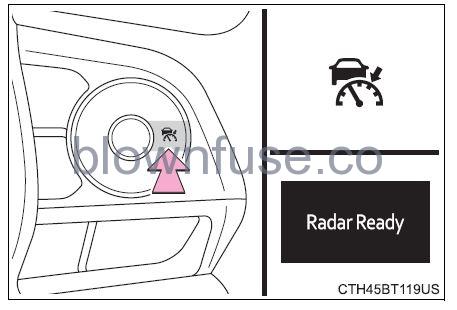
- A dynamic radar cruise control indicator will come on and a message will be displayed on the multi-information display.
- Press the switch again to deactivate the cruise control.
- If the cruise control main switch is pressed and held for 1.5 seconds or more, the system turns on in constant speed control mode. (P. 301)
- Accelerate or decelerate, with accelerator pedal operation, to the desired vehicle speed (at or above approximately 20 mph [30 km/h]) and press the “- SET” switch to set the speed.

- The cruise control “SET” indicator will come on.
- The vehicle speed at the moment the switch is released becomes the set speed.
Adjusting the set speed
Adjusting the set speed by the switch
To change the set speed, press the “+ RES” or “- SET” switch until the desired set speed is displayed.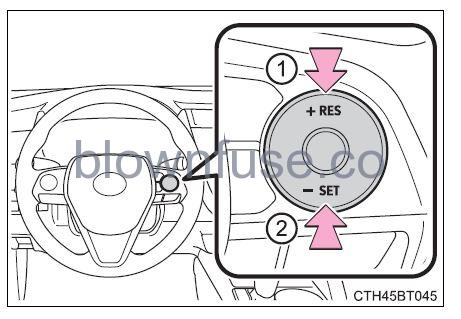
- Increases the speed (Except when the vehicle has been stopped by system control in vehicle-to-vehicle distance control mode) Decreases the speed
- Fine adjustment: Press the switch.
- Large adjustment: Press and hold the switch to change the speed, and release when the desired speed is reached.
In the vehicle-to-vehicle distance control mode, the set speed will be increased or decreased as follows:
- For the U.S. mainland and Hawaii
- Fine adjustment: By 1 mph (1.6 km/h)*1 or 1 km/h (0.6 mph)*2 each time the switch is pressed
- Large adjustment: Increases or decreases in 1 mph (1.6 km/h)*1 or 1 km/h (0.6 mph)*2 increments for as long as the switch is held
- For Canada, Guam and Puerto Rico
- Fine adjustment: By 1 mph (1.6 km/h)*1 or 1 km/h (0.6mph)*2 each time the switch is pressed
- Large adjustment: Increases or decreases in 5 mph (8 km/h)*1 or 5 km/h (3.1 mph)*2 increments for as long as the switch is held
- In the constant speed control mode (P. 301), the set speed will be increased or decreased as follows:
- Fine adjustment: By 1 mph (1.6 km/h)*1 or 1 km/h (0.6 mph)*2 each time the switch is pressed
- Large adjustment: The speed will continue to change while the switch is held.
- When the set speed is shown in “MPH”
- When the set speed is shown in “km/h”
Increasing the set speed by the accelerator pedal
- Accelerate with accelerator pedal operation to the desired vehicle speed
- Press the “- SET” switch
Changing the vehicle-to-vehicle distance (vehicle-to-vehicle distance control mode)
Pressing the switch changes the vehicle-to-vehicle distance as follows:
- Long
- Medium
- Short
Vehicle-to-vehicle distance settings (vehicle-to-vehicle distance control mode)
Select a distance from the table below. Note that the distances shown correspond to a vehicle speed of 50 mph (80 km/h). Vehicle-to-vehicle distance increases/decreases in accordance with vehicle speed. When the vehicle is stopped by system control, the vehicle stops at a certain vehicle-to-vehicle distance depending on the situation.
| Distance options | Vehicle-to-vehicle distance |
| Long | Approximately 160 ft. (50 m) |
| Medium | Approximately 130 ft. (40 m) |
| Short | Approximately 100 ft. (30 m) |
Resuming follow-up cruising when the vehicle has been stopped by system control (vehicle-to-vehicle distance control mode)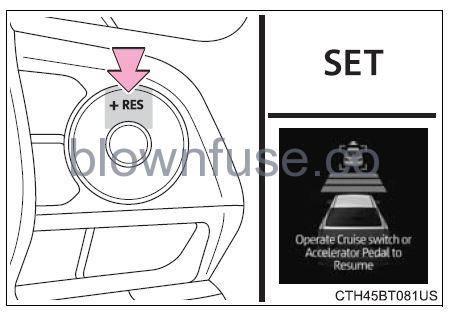
After the vehicle ahead of you starts off, press the “+ RES” switch. Your vehicle will also resume follow-up cruising if the accelerator pedal is depressed after the vehicle ahead of you starts off.
Canceling and resuming the speed control
- Pressing the cancel switch cancels the speed control.
- The speed control is also canceled when the brake pedal is depressed. (When the vehicle has been stopped by system control, depressing the brake pedal does not cancel the setting.)
- Pressing the “+ RES” switch resumes the cruise control and returns the vehicle speed to the set speed.
Approach warning (vehicle-to-vehicle distance control mode)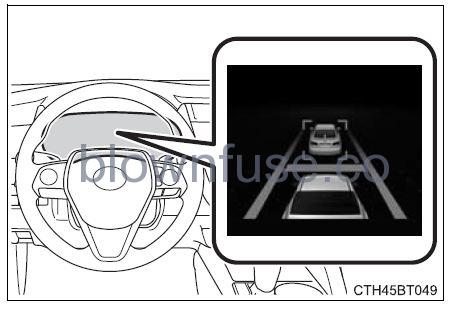
When your vehicle is too close to a vehicle ahead, and sufficient automatic deceleration via the cruise control is not possible, the display will flash and the buzzer will sound to alert the driver. An example of this would be if another driver cuts in front of you while you are following a vehicle. Depress the brake pedal to ensure an appropriate vehicle-to-vehicle distance.
Warnings may not occur when
In the following instances, warnings may not occur even when the vehicle-to-vehicle distance is small.
- When the speed of the preceding vehicle matches or exceeds your vehicle’s speed
- When the preceding vehicle is traveling at an extremely slow speed
- Immediately after the cruise control speed was set
- When depressing the accelerator pedal
Curve speed reduction function
While driving in vehicle-to-vehicle distance control mode, this function will reduce the vehicle speed, if it is determined to be necessary.
Function operation
- When the steering wheel begins to be turned, the vehicle speed will begin to be reduced. When the steering wheel is returned to the center position, the vehicle speed reduction will end.
- Depending on the situation, the vehicle speed will then return to the vehicle-to-vehicle distance control mode set speed.
- In situations where vehicle-to-vehicle distance control needs to operate, such as when a preceding vehicle cuts in front of your vehicle, the curve speed reduction function will be canceled.
Operation display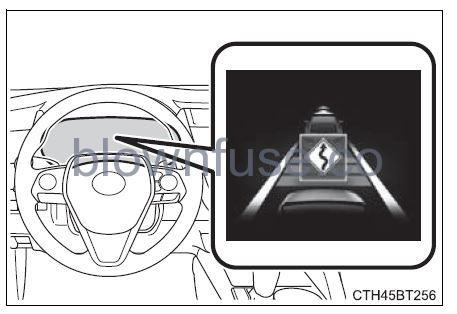
Displayed when the vehicle speed is being reduced. When the vehicle speed reduction ends, the display will disappear.
Changing the settings of the curve speed reduction function can be enabled/disabled and the vehicle speed reduction strength can be adjusted on  (4.2-inch display) or
(4.2-inch display) or  (7-inch display) (P. 103, 117) of the multi-information display. The setting will change each time
(7-inch display) (P. 103, 117) of the multi-information display. The setting will change each time ![]() of the meter control switch is pressed.
of the meter control switch is pressed.
Selecting constant speed control mode
When a constant speed control mode is selected, your vehicle will maintain a set speed without controlling the vehicle-to-vehicle distance. Select this mode only when vehicle-to-vehicle distance control mode does not function correctly due to a dirty radar, etc.
- With the cruise control off, press and hold the cruise control main switch for 1.5 seconds or more.
Immediately after the switch is pressed, the dynamic radar cruise control indicator will come on. Afterward, it switches to the cruise control indicator.- Switching to constant speed control mode is only possible when operating the switch with the cruise control off.
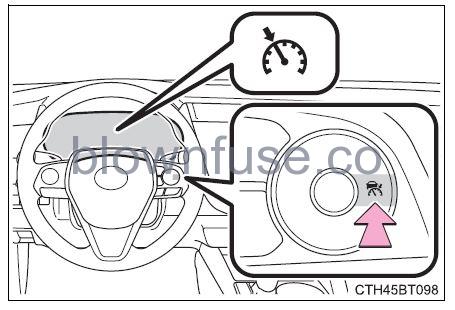
- Switching to constant speed control mode is only possible when operating the switch with the cruise control off.
- Accelerate or decelerate, with accelerator pedal operation, to the desired vehicle speed (at or above approximately 20 mph [30 km/h]) and press the “- SET” switch to set the speed.
Dynamic radar cruise control with full-speed range can be set when
- The shift lever is in D.
- The desired set speed can be set when the vehicle speed is approximately 20 mph (30 km/h) or more. (However, when the vehicle speed is set while driving at below approximately 20 mph [30 km/h], the set speed will be set to approximately 20 mph [30 km/h].)
Accelerating after setting the vehicle speed
The vehicle can accelerate by operating the accelerator pedal. After accelerating, the set speed resumes. However, during vehicle-to-vehicle distance control mode, the vehicle speed may decrease below the set speed in order to maintain the distance to the preceding vehicle.
When the vehicle stops while follow-up cruising
● Pressing the “+ RES” switch while the vehicle ahead stops will resume follow-up cruising if the vehicle ahead starts off within approximately 3 seconds after the switch is pressed.
● If the vehicle ahead starts off within 3 seconds after your vehicle stops, follow-up cruising will be resumed.
Automatic cancelation of vehicle-to-vehicle distance control mode Vehicle-to-vehicle distance control mode is automatically canceled in the following situations:
- VSC is activated.
- TRAC is activated for a period of time.
- When the VSC or TRAC system is turned off.
- The sensor cannot detect correctly because it is covered in some way.
- When the brake control or output restriction control of a driving support system operates. (For example Pre-Collision System, Drive-Start Control)
- The parking brake is operated.
- The vehicle is stopped by system control on a steep incline.
- The following are detected when the vehicle has been stopped by system control:
- The driver is not wearing a seat belt.
- The driver’s door is opened.
- The vehicle has been stopped for about 3 minutes
If vehicle-to-vehicle distance control mode is automatically canceled for any reason other than the above, there may be a malfunction in the system. Contact your Toyota dealer.
Automatic cancelation of constant speed control mode
Constant speed control mode is automatically canceled in the following situations:
- The actual vehicle speed is more than approximately 10 mph (16 km/h) below the set vehicle speed.
- Actual vehicle speed falls below approximately 20 mph (30 km/h).
- VSC is activated.
- TRAC is activated for a period of time.
- When the VSC or TRAC system is turned off.
- When the brake control or output restriction control of a driving support system operates. (For example Pre-Collision System, Drive-Start Control)
- The parking brake is operated.
If constant speed control mode is automatically canceled for any reason other than the above, there may be a malfunction in the system. Contact your Toyota dealer.
Situations in which the curve speed reduction function may not operate
In situations such as the following, the curve speed reduction function may not operate:
- When the vehicle is being driven around a gentle curve
- When the accelerator pedal is being depressed
- When the vehicle is being driven around an extremely short curve
Brake operation
A brake operation sound may be heard and the brake pedal response may change, but these are not malfunctions.
Warning messages and buzzers for dynamic radar cruise control with full-speed range
Warning messages and buzzers are used to indicate a system malfunction or to inform the driver of the need for caution while driving. If a warning message is shown on the multi-information display, read the message and follow the instructions. (P. 252, 538)
When the sensor may not be correctly detecting the vehicle ahead
In the case of the following and depending on the conditions, operate the brake pedal when deceleration of the system is insufficient or operate the accelerator pedal when acceleration is required.
As the sensor may not be able to correctly detect these types of vehicles, the approach warning (P. 299) may not be activated.
- Vehicles that cut in suddenly
- Vehicles traveling at low speeds
- Vehicles that are not moving in the same lane
- Vehicles with small rear ends (trailers with no load on board, etc.)
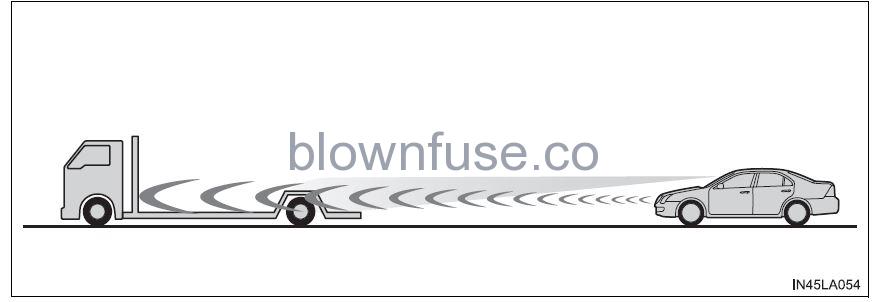
- Motorcycles traveling in the same lane
- When water or snow was thrown up by the surrounding vehicles hinders the detection of the sensor
- When your vehicle is pointing upwards (caused by a heavy load in the luggage compartment, etc.)

- The preceding vehicle has an extremely high ground clearance
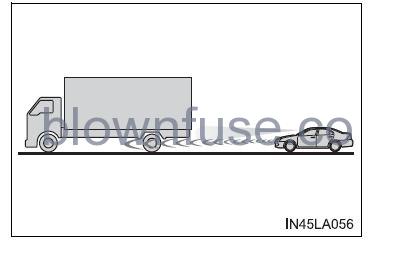
Conditions under which the vehicle-to-vehicle distance control mode may not function correctly
In the case of the following conditions, operate the brake pedal (or accelerator pedal, depending on the situation) as necessary. As the sensor may not be able to correctly detect vehicles ahead, the system may not operate properly.
- When the road curves or when the lanes are narrow
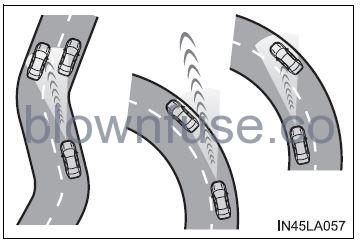
- When steering wheel operation or your position in the lane is unstable
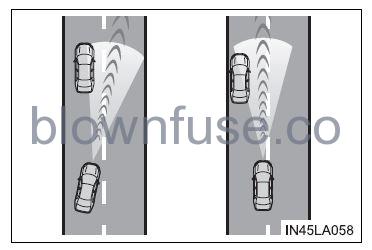
- When the vehicle ahead of you decelerates suddenly
- When driving on a road surrounded by a structure, such as in a tunnel or on a bridge
- While the vehicle speed is decreasing to the set speed after the vehicle accelerates by depressing the accelerator pedal
Situations in which the curve speed reduction function may not operate properly
In situations such as the following, the curve speed reduction function may not operate properly:
- When the vehicle is being driven around a curve on an incline/decline
- When the course of the vehicle differs from the shape of the curve
- When the vehicle speed is excessively high when entering a curve
- When the steering wheel is suddenly operated
Dynamic radar cruise control
Summary of functions
In vehicle-to-vehicle distance control mode, the vehicle automatically accelerates and decelerates to match the speed changes of the preceding vehicle even if the accelerator pedal is not depressed. In constant speed control mode, the vehicle runs at a fixed speed. Use the dynamic radar cruise control on freeways and highways.
System Components
Meter display
- Multi-information display
- Set speed
- Indicators
Operation switches
- Vehicle-to-vehicle distance switch
- “+ RES” switch
- Cruise control main switch Cancel switch
- “- SET” switch
WARNING
- Before using dynamic radar cruise control
- Driving safely is the sole responsibility of the driver. Do not rely solely on the system, and drive safely by always paying careful attention to your surroundings.
- The dynamic radar cruise control provides driving assistance to reduce the driver’s burden. However, there are limitations to the assistance provided. Read the following conditions carefully. Do not overly rely on this system and always drive carefully.
- Set the speed appropriately depending on the speed limit, traffic flow, road conditions, weather conditions, etc. The driver is responsible for checking the set speed.
- Even when the system is functioning normally, the condition of the preceding vehicle as detected by the system may differ from the condition observed by the driver. Therefore, the driver must always remain alert, assess the danger of each situation, and drive safely. Relying solely on this system or assuming the system ensures safety while driving can lead to an accident, resulting in death or serious injury.
- Switch the dynamic radar cruise control set to off, using the cruise control main switch when not in use.
WARNING
- Cautions regarding the driving assist systems Observe the following precautions, as there are limitations to the assistance provided by the system.
Failure to do so may cause an accident resulting in death or serious injury.- Assisting the driver to measure the following distance
- The dynamic radar cruise control is only intended to help the driver in determining the following distance between the driver’s own vehicle and a designated vehicle traveling ahead. It is not a mechanism that allows careless or inattentive driving, and it is not a system that can assist the driver in low-visibility conditions.
It is still necessary for the driver to pay close attention to the vehicle’s surroundings.
- The dynamic radar cruise control is only intended to help the driver in determining the following distance between the driver’s own vehicle and a designated vehicle traveling ahead. It is not a mechanism that allows careless or inattentive driving, and it is not a system that can assist the driver in low-visibility conditions.
- Assisting the driver to judge proper following distance
- The dynamic radar cruise control determines whether the following distance between the driver’s own vehicle and a designated vehicle traveling ahead is within a set range. It is not capable of making any other type of judgment. Therefore, it is absolutely necessary for the driver to remain vigilant and to determine whether or not there is a possibility of danger in any given situation.
- Assisting the driver to operate the vehicle
- The dynamic radar cruise control does not include functions that will prevent or avoid collisions with vehicles ahead of your vehicle. Therefore, if there is ever any possibility of danger, the driver must take immediate and direct control of the vehicle and act appropriately in order to ensure the safety of all involved.
- Assisting the driver to measure the following distance
WARNING
- Situations unsuitable for dynamic radar cruise control Do not use dynamic radar cruise control in any of the following situations. Doing so may result in inappropriate speed control and could cause an accident resulting in death or serious injury.
- Roads where there are pedestrians, cyclists, etc.
- In heavy traffic
- On roads with sharp bends
- On winding roads
- On slippery roads, such as those covered with rain, ice, or snow
- On steep downhills, or where there are sudden changes between sharp up and down gradients Vehicle speed may exceed the set speed when driving down a steep hill.
- At entrances to freeways and highways
- When weather conditions are bad enough that they may prevent the sensors from detecting correctly (fog, snow, sandstorm, heavy rain, etc.)
- When there is rain, snow, etc. on the front surface of the radar or front camera
- In traffic conditions that require frequent repeated acceleration and deceleration
- During emergency towing
- When an approach warning buzzer is heard often
Driving in vehicle-to-vehicle distance control mode
This mode employs radar to detect the presence of vehicles up to approximately 328 ft. (100 m) ahead, determines the current vehicle-to-vehicle following distance, and operates to maintain a suitable following distance from the vehicle ahead. The desired vehicle-to-vehicle distance can also be set by operating the vehicle-to-vehicle distance switch. When driving on downhill slopes, the vehicle-to-vehicle distance may become shorter.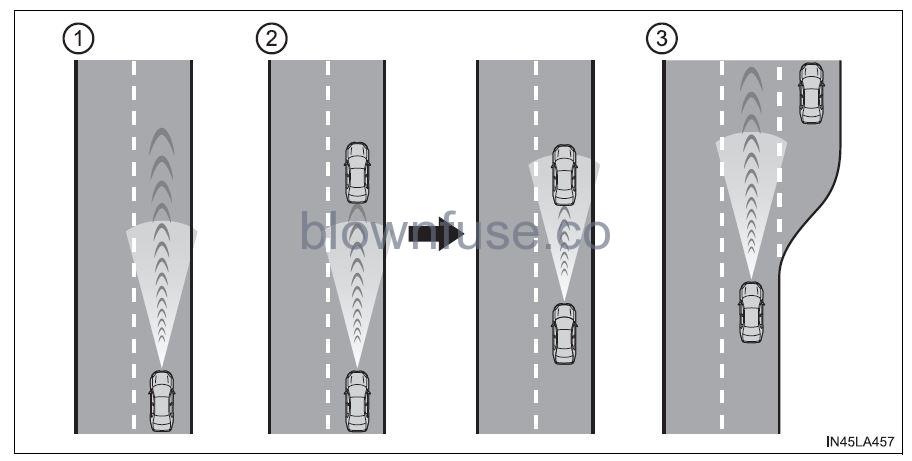
- Example of constant speed cruising When there are no vehicles ahead The vehicle travels at the speed set by the driver.
- Examples of deceleration cruising and follow-up cruising
- When a preceding vehicle driving slower than the set speed appears
- When a vehicle is detected running ahead of you, the system automatically decelerates your vehicle. When a greater reduction in vehicle speed is necessary, the system applies the brakes (the stoplights will come on at this time). The system will respond to changes in the speed of the vehicle ahead in order to maintain the vehicle-to-vehicle distance set by the driver. Approach warning warns you when the system cannot decelerate sufficiently to prevent your vehicle from closing in on the vehicle ahead.
- When the turn signal lever is operated and your vehicle moves to an over-taking lane while driving at 50 mph (80 km/h) or more, the vehicle will accelerate to help to overtake a passing vehicle.
- The system’s identification of what is an overtaking lane may be determined solely based on the location of the steering wheel in the vehicle (left-side driver position versus right-side driver position.) If the vehicle is driven to a region where the overtaking lane is on a different side from where the vehicle is normally driven, the vehicle may accelerate when the turn signal lever is operated in the opposite direction to the overtaking lane (e.g., if the driver normally operates the vehicle in a region where the overtaking lane is to the right but then drives to a region where the overtaking lane is to the left, the vehicle may accelerate when the right turn signal is activated).
- Example of acceleration
- When there are no longer any preceding vehicles driving slower than the set speed
- The system accelerates until the set speed is reached. The system then returns to constant speed cruising.
Setting the vehicle speed (vehicle-to-vehicle distance control mode)
- Press the cruise control main switch to activate the cruise control.
- A dynamic radar cruise control indicator will come on and a message will be displayed on the multi-information display.
- Press the switch again to deactivate the cruise control.
- If the cruise control main switch is pressed and held for 1.5 seconds or more, the system turns on in constant speed control mode. (P. 317)
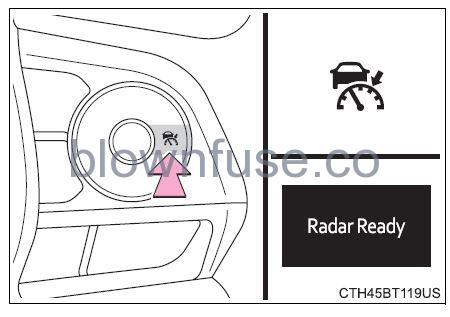
- Accelerate or decelerate, with accelerator pedal operation, to the desired vehicle speed (at or above approximately 20 mph [30 km/h]) and press the “-SET” switch to set the speed.
- The cruise control “SET” indicator will come on.
- The vehicle speed at the moment the switch is released becomes the set speed.
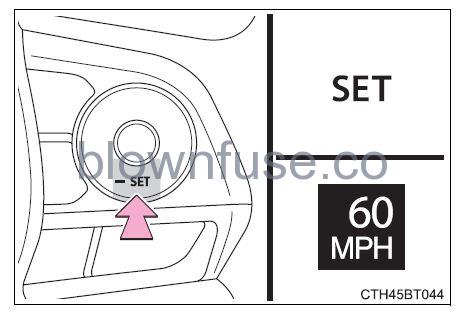
Adjusting the set speed
Adjusting the set speed by the switch
To change the set speed, press the “+ RES” or “- SET” switch until the desired set speed is displayed.
- Increases the speed
- Decreases the speed
- Fine adjustment: Press the switch.
- Large adjustment: Press and hold the switch to change the speed, and release when the desired speed is reached.
In the vehicle-to-vehicle distance control mode, the set speed will be increased or decreased as follows:
For U.S. mainland and Hawaii
Fine adjustment: By 1 mph (1.6 km/h)*1 or 1 km/h (0.6 mph)*2 each time the switch is pressed Large adjustment: Increases or decreases in 1 mph (1.6 km/h)*1 or 1 km/h (0.6 mph)*2 increments for as long as the switch is held
For Canada, Guam and Puerto Rico
Fine adjustment: By 1 mph (1.6 km/h)*1 or 1 km/h (0.6 mph)*2 each time the switch is pressed Large adjustment: Increases or decreases by 5 mph (8 km/h)*1 or 5 km/h (3.1 mph)*2 increments for as long as the switch is held In the constant speed control mode (P. 317), the set speed will be increased or decreased as follows:
Fine adjustment: By 1 mph (1.6 km/h)*1 or 1 km/h (0.6 mph)*2 each time the switch is pressed Large adjustment: The speed will continue to change while the switch is held.
- When the set speed is shown in “MPH”
- When the set speed is shown in “km/h”
Increasing the set speed by the accelerator pedal
- Accelerate with accelerator pedal operation to the desired vehicle speed
- Press the “- SET” switch
Changing the vehicle-to-vehicle distance (vehicle-to-vehicle distance control mode)
Pressing the switch changes the vehicle-to-vehicle distance as follows: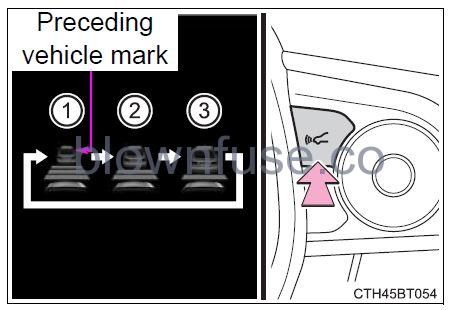
- Long
- Medium
- Short
Vehicle-to-vehicle distance settings (vehicle-to-vehicle distance control mode)
| Distance options | Vehicle-to-vehicle distance |
| Long | Approximately 160 ft. (50 m) |
| Medium | Approximately 130 ft. (40 m) |
| Short | Approximately 100 ft. (30 m) |
Select a distance from the table below. Note that the distances shown correspond to a vehicle speed of 50 mph (80 km/h). Vehicle-to-vehicle distance increases/decreases in accordance with vehicle speed.
Canceling and resuming the speed control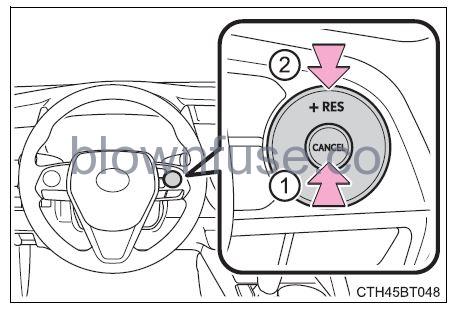
- Pressing the cancel switch can-cels the speed control.
- The speed control is also canceled when the brake pedal is depressed.
- Pressing the “+ RES” switch resumes the cruise control and returns the vehicle speed to the set speed.
However, cruise control does not resume when the vehicle speed is approximately 16 mph (25 km/h) or less.
Approach warning (vehicle-to-vehicle distance control mode)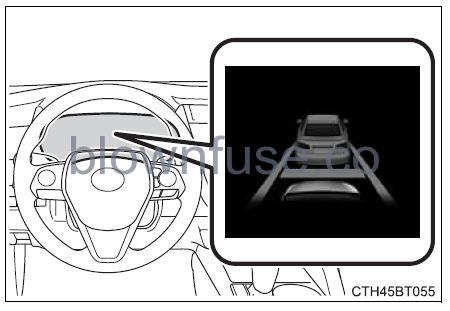
When your vehicle is too close to a vehicle ahead, and sufficient automatic deceleration via the cruise control is not possible, the display will flash and the buzzer will sound to alert the driver. An example of this would be if another driver cuts in front of you while you are following a vehicle. Depress the brake pedal to ensure an appropriate vehicle-to-vehicle distance.
Warnings may not occur when
In the following instances, warnings may not occur even when the vehicle-to-vehicle distance is small.
- When the speed of the preceding vehicle matches or exceeds your vehicle’s speed
- When the preceding vehicle is traveling at an extremely slow speed
- Immediately after the cruise control speed was set
- When depressing the accelerator pedal
Curve speed reduction function
While driving in vehicle-to-vehicle distance control mode, this function will reduce the vehicle speed, if it is determined to be necessary.
Function operation
- When the steering wheel begins to be turned, the vehicle speed will begin to be reduced. When the steering wheel is returned to the center position, the vehicle speed reduction will end.
- Depending on the situation, the vehicle speed will then return to the vehicle-to-vehicle distance control mode set speed.
- In situations where vehicle-to-vehicle distance control needs to operate, such as when a preceding vehicle cuts in front of your vehicle, the curve speed reduction function will be canceled.
Operation display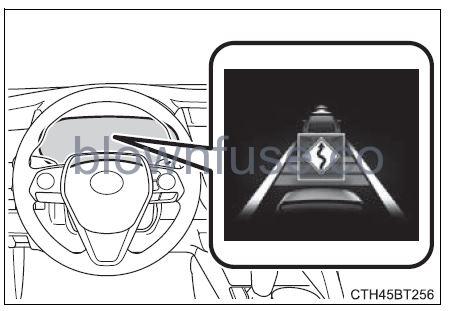
Displayed when the vehicle speed is being reduced. When the vehicle speed reduction ends, the display will disappear.
Changing the settings of the curve speed reduction function can be enabled/disabled and the vehicle speed reduction strength can be adjusted on  (4.2-inch display) or
(4.2-inch display) or  (7-inch display) (P. 103, 117) of the multi-information display.
(7-inch display) (P. 103, 117) of the multi-information display.
The setting will change each time ![]() of the meter control switch is pressed
of the meter control switch is pressed
Selecting constant speed control mode
When a constant speed control mode is selected, your vehicle will maintain a set speed without controlling the vehicle-to-vehicle distance. Select this mode only when vehicle-to-vehicle distance control mode does not function correctly due to a dirty radar, etc.
- With the cruise control off,
- press and hold the cruise control main switch for 1.5 seconds or more.
- Immediately after the switch is pressed, the dynamic radar cruise control indicator will come on. Afterward, it switches to the cruise control indicator.
- Switching to constant speed control mode is only possible when operating the switch with the cruise control off.

- Accelerate or decelerate, with accelerator pedal operation, to the desired vehicle speed (at or above approximately 20 mph [30 km/h]) and press the “-SET” switch to set the speed.
Dynamic radar cruise control can be set when
- The shift lever is in D.
- Depending on the control mode, this item can be set at the following speeds.
- Vehicle-to-vehicle distance control mode: Approximately 20 mph (30 km/h) or more
- Constant speed control mode: Approximately 20 mph (30 km/h) or more
Accelerating after setting the vehicle speed
The vehicle can accelerate by operating the accelerator pedal. After accelerating, the set speed resumes. However, during vehicle-to-vehicle distance control mode, the vehicle speed may decrease below the set speed in order to maintain the distance to the preceding vehicle.
Automatic cancelation of vehicle-to-vehicle distance control mode Vehicle-to-vehicle distance control mode is automatically canceled in the following situations:
- Actual vehicle speed falls below approximately 16 mph (25 km/h).
- VSC is activated.
- TRAC is activated for a period of time.
- When the VSC or TRAC system is turned off.
- The sensor cannot detect correctly because it is covered in some way.
- When the brake control or output restriction control of a driving support system operates. (For example Pre-Collision System, Drive-Start Control)
- The parking brake is operated.
If vehicle-to-vehicle distance control mode is automatically canceled for any reason other than the above, there may be a malfunction in the system. Contact your Toyota dealer.
Automatic cancelation of constant speed control mode
Constant speed control mode is automatically canceled in the following situations:
- The actual vehicle speed is more than approximately 10 mph (16 km/h) below the set vehicle speed.
- Actual vehicle speed falls below approximately 20 mph (30 km/h).
- VSC is activated.
- TRAC is activated for a period of time.
- When the VSC or TRAC system is turned off.
- When the brake control or output restriction control of a driving support system operates. (For example Pre-Collision System, Drive-Start Control)
- The parking brake is operated.
If constant speed control mode is automatically canceled for any reason other than the above, there may be a malfunction in the system. Contact your Toyota dealer.
Situations in which the curve speed reduction function may not operate
In situations such as the following, the curve speed reduction function may not operate:
- When the vehicle is being driven around a gentle curve
- When the accelerator pedal is being depressed
- \When the vehicle is being driven around an extremely short curve
Brake operation
A brake operation sound may be heard and the brake pedal response may change, but these are not malfunctions.
Warning messages and buzzers for dynamic radar cruise control
Warning messages and buzzers are used to indicate a system malfunction or to inform the driver of the need for caution while driving. If a warning message is shown on the multi-information display, read the message and follow the instructions. (P. 252, 538)
When the sensor may not be correctly detecting the vehicle ahead
In the case of the following and depending on the conditions, operate the brake pedal when deceleration of the system is insufficient or operate the accelerator pedal when acceleration is required.
As the sensor may not be able to correctly detect these types of vehicles, the approach warning (P. 315) may not be activated.
- Vehicles that cut in suddenly
- Vehicles traveling at low speeds
- Vehicles that are not moving in the same lane
- Vehicles with small rear ends (trailers with no load on board, etc.)

- Motorcycles traveling in the same lane
- When water or snow was thrown up by the surrounding vehicles hinders the detection of the sensor
- When your vehicle is pointing upwards (caused by a heavy load in the luggage compartment, etc.)

- The preceding vehicle has an extremely high ground clearance
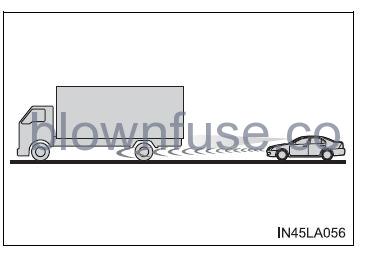
Conditions under which the vehicle-to-vehicle distance control mode may not function correctly
In the case of the following conditions, operate the brake pedal (or accelerator pedal, depending on the situation) as necessary.
As the sensor may not be able to correctly detect vehicles ahead, the system may not operate properly.
- When the road curves or when the lanes are narrow

- When steering wheel operation or your position in the lane is unstable

- When the vehicle ahead of you decelerates suddenly
- When driving on a road surrounded by a structure, such as in a tunnel or on a bridge
- While the vehicle speed is decreasing to the set speed after the vehicle accelerates by depressing the accelerator pedal
Situations in which the curve speed reduction function may not operate properly
In situations such as the following, the curve speed reduction function may not operate properly:
- When the vehicle is being driven around a curve on an incline/decline
- When the course of the vehicle differs from the shape of the curve
- When the vehicle speed is excessively high when entering a curve
- When the steering wheel is suddenly operated
Driving assist systems
To keep driving safety and performance, the following systems operate automatically in response to various driving situations. Be aware, however, that these systems are supplementary and should not be relied upon too heavily when operating the vehicle.
- ABS (Anti-lock Brake System)
- Helps to prevent wheel lock when the brakes are applied suddenly, or if the brakes are applied while driving on a slippery road surface
- Brake assist
- Generates an increased level of braking force after the brake pedal is depressed when the system detects a panic stop situation
- VSC (Vehicle Stability Control)
- Helps the driver to control skidding when swerving suddenly or turning on slippery road surfaces.
- Enhanced VSC (Enhanced Vehicle Stability Control)
- Provides cooperative control of the ABS, TRAC, VSC and EPS.
Helps to maintain directional stability when swerving on slippery road surfaces by controlling steering performance.
- Provides cooperative control of the ABS, TRAC, VSC and EPS.
- Secondary Collision Brake
- When the airbag sensor detects a collision and the system operates, the brakes and stop lights are automatically controlled to reduce the vehicle speed and help reduce the possibility of further
damage due to a secondary collision
- When the airbag sensor detects a collision and the system operates, the brakes and stop lights are automatically controlled to reduce the vehicle speed and help reduce the possibility of further
- TRAC (Traction Control)
- Helps to maintain drive power and prevent the drive wheels from spinning when starting the vehicle or accelerating on slippery roads
- Active Cornering Assist (ACA) (if equipped)
- Helps to prevent the vehicle from sliding to the outer side by performing inner wheel brake control when attempting to accelerate while turning
- Hill-start assist control
- Helps to reduce the backward movement of the vehicle when starting on an uphill
- EPS (Electric Power Steering)
- Employs an electric motor to reduce the amount of effort needed to turn the steering wheel
- BSM (Blind Spot Monitor) (if equipped) P. 330
- Dynamic Torque-Control AWD system (if equipped) Automatically switches from front-wheel drive to all-wheel drive (AWD) according to the driving conditions, helping to ensure reliable handling and stability. Examples of conditions where the system will switch to AWD are when cornering, going uphill, starting off or accelerating, and when the road surface is slippery due to snow, rain, etc.
When the TRAC/VSC systems are operating
The slip indicator light will flash while the TRAC/VSC systems are operating.
Disabling the TRAC system
If the vehicle gets stuck in mud, dirt or snow, the TRAC system may reduce power from the engine to the wheels. Pressing  to turn the system off may make it easier for you to rock the vehicle in order to free it.
to turn the system off may make it easier for you to rock the vehicle in order to free it.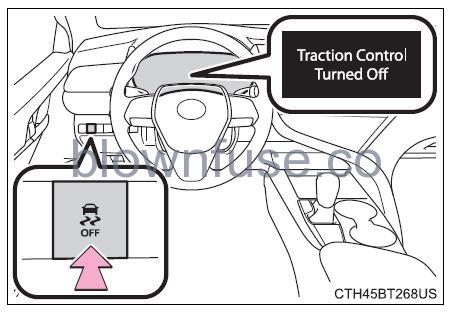
- To turn the TRAC system off, quickly press and release
 . “Traction Control Turned Off” will be shown on the multi-information display.
. “Traction Control Turned Off” will be shown on the multi-information display. - Press again to turn the system back on.
Turning off both TRAC and VSC systems
- To turn the TRAC and VSC systems off, press and hold
 for more than 3 seconds while the vehicle is stopped. The VSC OFF indicator light will come on and the “Traction Control Turned Off” will be shown on the multi-information display*.
for more than 3 seconds while the vehicle is stopped. The VSC OFF indicator light will come on and the “Traction Control Turned Off” will be shown on the multi-information display*. - Press
 again to turn the systems back on.
again to turn the systems back on.
PCS (Pre-Collision System) will also be disabled (only Pre-Collision warning is available). The pre-collision system warning light will come on and the message will be shown on the multi-information display. (P. 269)
When the message is displayed on the multi-information display showing that TRAC has been disabled even if  has not been pressed TRAC is temporary deactivated. If the information continues to show, contact your Toyota dealer
has not been pressed TRAC is temporary deactivated. If the information continues to show, contact your Toyota dealer
Operating conditions of hill-start assist control
When the following four conditions are met, the hill-start assist control will operate:
- The shift lever is in a position other than P or N (when starting off forward/backward on an upward incline)
- The vehicle is stopped
- The accelerator pedal is not depressed
- The parking brake is not engaged
Automatic system cancelation of hill-start assist control
The hill-start assist control will turn off in any of the following situations:
- The shift lever is shifted to P or N
- The accelerator pedal is depressed
- The parking brake is engaged
- 2 seconds at maximum elapsed after the brake pedal is released
Sounds and vibrations caused by the ABS, brake assist, VSC, TRAC, and hill-start assist control systems
- A sound may be heard from the engine compartment when the brake pedal is depressed repeatedly when the engine is started or just after the vehicle begins to move. This sound does not indicate that a malfunction has occurred in any of these systems.
- Any of the following conditions may occur when the above systems are operating. None of these indicates that a malfunction has occurred.
- Vibrations may be felt through the vehicle body and steering.
- A motor sound may be heard also after the vehicle comes to a stop.
- The brake pedal may pulsate slightly after the ABS is activated.
- The brake pedal may move down slightly after the ABS is activated.
Active Cornering Assist operation sounds and vibrations
When the Active Cornering Assist is operated, operation sounds and vibrations may be generated from the brake system, but this is not a malfunction.
EPS operation sound
When the steering wheel is operated, a motor sound (whirring sound) may be heard. This does not indicate a malfunction.
Automatic reactivation of TRAC and VSC systems
After turning the TRAC and VSC systems off, the systems will be automatically re-enabled in the following situations:
- When the engine switch is turned off
- If only the TRAC system is turned off, the TRAC will turn on when vehicle speed increases
- If both the TRAC and VSC systems are turned off, automatic re-enabling will not occur when vehicle speed increases.
Operating conditions of Active Cornering Assist
The system operates when the following occurs.
- TRAC/VSC can operate
- The driver is attempting to accelerate while turning
- The system detects that the vehicle is sliding to the outer side
- The brake pedal is released
Secondary Collision Brake operating conditions
The system operates when the SRS airbag sensor detects a collision while the vehicle is in motion. However, the system does not operate in any of the following situations.
- The vehicle speed is below 6 mph (10 km/h)
- Components are damaged
Secondary Collision Brake automatic cancellation
The Secondary Collision Brake is automatically canceled in the following situations:
- The vehicle speed drops below approximately 6 mph (10 km/h)
- A certain amount of time elapses during the operation
- The accelerator pedal is depressed a large amount
Reduced effectiveness of the EPS system
The effectiveness of the EPS system is reduced to prevent the system from overheating when there is frequent steering input over an extended period of time. The steering wheel may feel heavy as a result.
Should this occur, refrain from excessive steering input or stop the vehicle and turn the engine off. The EPS system should return to normal within 10 minutes.
If a message about AWD is shown on the multi-information display Perform the following actions
| Message | Details/Actions |
|
“AWD System Overheated Switching to 2WD Mode” |
AWD system is overheating.
® Perform the following actions. • Reduce the vehicle speed until the mes- sage disappears. • Stop the vehicle in a safe place and let the engine idle. Once the display message on the multi- information display turns off, there is no problem continuing to drive. If the message does not disappear, have your vehicle checked by your Toyota dealer immediately. |
|
“AWD System Overheated 2WD Mode Engaged” |
The vehicle switched from all-wheel drive (AWD) to front wheel drive due to overheat- ing.
® Perform the following actions. • Reduce the vehicle speed until the mes- sage disappears. • Stop the vehicle in a safe place and let the engine idle. Once the display message on the multi- information display turns off, the AWD sys- tem returns to normal. If the message does not disappear, have your vehicle checked by your Toyota dealer immediately. |
| “AWD System Malfunction 2WD Mode Engaged
Visit Your Dealer” |
A malfunction occurred in the AWD system.
® Have your vehicle checked by your Toyota dealer immediately. |
The ABS does not operate effectively when
- The limits of tire-gripping performance have been exceeded (such as excessively worn tires on a snow-covered road).
- The vehicle hydroplanes while driving at high speed on wet or slick roads.
Stopping distance when the ABS is operating may exceed that of normal conditions
The ABS is not designed to shorten the vehicle’s stopping distance. Always maintain a safe distance from the vehicle in front of you, especially in the following situations:
- When driving on dirt, gravel or snow-covered roads
- When driving with tire chains
- When driving over bumps on the road
- When driving over roads with potholes or uneven surfaces
TRAC/VSC may not operate effectively when
Directional control and power may not be achievable while driving on slippery road surfaces, even if the TRAC/VSC system is operating. Drive the vehicle carefully in conditions where stability and power may be lost.
Active Cornering Assist does not operate effectively when
- Do not overly rely on Active Cornering Assist. Active Cornering Assist may not operate effectively when accelerating down slopes or driving on slippery road surfaces.
- When Active Cornering Assist frequently operates, Active Cornering Assist may temporarily stop operating to ensure proper operation of the brakes, TRAC, and VSC.
WARNING
- Hill-start assist control does not operate effectively when
- Do not overly rely on hill-start assist control. Hill-start assists control may not operate effectively on steep inclines and roads covered with ice.
- Unlike the parking brake, hill-start assists control is not intended to hold the vehicle stationary for an extended period of time. Do not attempt to use hill-start assist control to hold the vehicle on an incline, as doing so may lead to an accident.
- When the TRAC/VSC is activated
- The slip indicator light flashes. Always drive carefully. Reckless driving may cause an accident. Exercise particular care when the indicator light flashes.
- When the TRAC/VSC systems are turned off
- Be especially careful and drive at a speed appropriate to the road conditions. As these are the systems to help ensure vehicle stability and driving force, do not turn the TRAC/VSC systems off unless necessary. Secondary Collision Brake
- Do not overly rely solely upon the Secondary Collision Brake. This system is designed to help reduce the possibility of further damage due to a secondary collision, however, that effect changes according to various conditions. Overly relying on the system may result in death or serious injury.
- Replacing tires
- Make sure that all tires are of the specified size, brand, tread pattern, and total load capacity. In addition, make sure that the tires are inflated to the recommended tire inflation pressure level.
- The ABS, TRAC, and VSC systems will not function correctly if different tires are installed on the vehicle.
- Contact your Toyota dealer for further information when replacing tires or wheels.
- Handling of tires and the suspension
- Using tires with any kind of problem or modifying the suspension will affect the driving assist systems, and may cause a system to malfunction.
System components
- Multi-information display Turning the BSM function on/off. (P. 331)
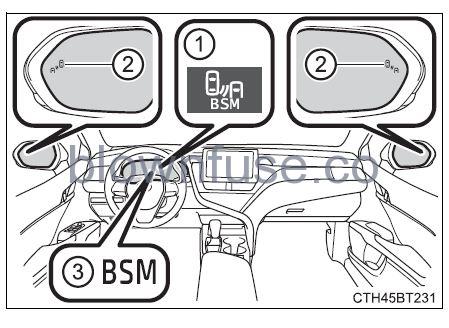
- Outside rearview mirror indicators
- When a vehicle is detected in a blind spot of the outside rearview mirrors or approaching rapidly from behind into a blind spot, the outside rearview mirror indicator on the detected side will illuminate. If the turn signal lever is operated toward the detected side, the outside rearview mirror indicator flashes.
- “BSM” indicator
- When the BSM function is turned on, the indicator illuminates.
Turning the BSM function on/off
- Vehicles with 4.2-inch multi-information display
- Press
 of the meter control switches, select
of the meter control switches, select  .
. - Press
 of the meter control switches, select
of the meter control switches, select  .
. - Press
 the meter control switch.
the meter control switch. - Each time
 is pressed, the function changes on/off.
is pressed, the function changes on/off.
- Press
- Vehicles with 7-inch multi-information display
- Press
 of the meter control switches, select
of the meter control switches, select  .
. - Press
 of the meter control switches, select
of the meter control switches, select  .
. - Press
 the meter control switch.
the meter control switch. - Each time
 is pressed, the function changes on/off.
is pressed, the function changes on/off.
- Press
Setting the outside rearview mirror indicator brightness
The brightness of the indicators on the outside rearview mirrors can be changed on  (4.2-inch display) or
(4.2-inch display) or  (7-inch display) (P. 106, 119) of the multi-information display.
(7-inch display) (P. 106, 119) of the multi-information display.
The outside rearview mirror indicators’ visibility
When under strong sunlight, the outside rearview mirror indicator may be difficult to see.
When “Blind Spot Monitor Unavailable” is shown on the multi-information display
Ice, snow, mud, etc., may be attached to the rear bumper around the sensors. ( P. 332) The system should return to normal operation after removing the ice, snow, mud, etc. from the rear bumper.
Additionally, the sensors may not operate normally when driving in extremely hot or cold environments.
When there is a malfunction in the Blind Spot Monitor
If a system malfunction is detected due to any of the following reasons, a warning message will be displayed:
- There is a malfunction with the sensors
- The sensors have become dirty
- The outside temperature is extremely high or low
- The sensor voltage has become abnormal
WARNING
- To ensure the system can operate properly
- Blind Spot Monitor sensors are installed behind the left and right sides of the rear bumper respectively. Observe the following to ensure the Blind Spot Monitor can function correctly.
- Keep the sensor and its surrounding area on the bumper clean at all times. If a sensor or its surrounding area on the rear bumper is dirty or covered with snow, the Blind Spot Monitor may not operate and a warning message (P. 331) will be displayed.
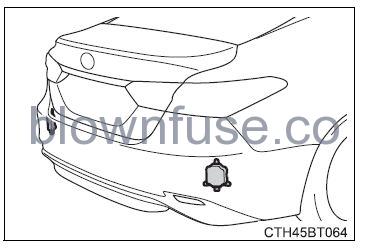
- In this situation, clear off the dirt or snow and drive the vehicle with the operating conditions of the BSM function (P. 334) satisfied for approximately 10 minutes.
- If the warning message does not disappear, have the vehicle inspected by your Toyota dealer
- Do not subject a sensor or its surrounding area on the rear bumper to a strong impact.
- If a sensor is moved even slightly off position, the system may malfunction and vehicles may not be detected correctly.
- In the following situations, have your vehicle inspected by your Toyota dealer.
- A sensor or its surrounding area is subject to a strong impact.
- If the surrounding area of a sensor is scratched or dented, or part of them has become disconnected.
- Do not disassemble the sensor.
- Do not attach accessories or stickers to the sensor or surrounding area on the bumper.
- Do not modify the sensor or surrounding area on the bumper.
- If a sensor or the rear bumper needs to be removed/installed or replaced, contact your Toyota dealer.
- Do not paint the rear bumper any color other than an official Toyota color.
BSM function
The BSM function uses radar sensors to detect the following vehicles traveling in an adjacent lane in the area that is usually not reflected in the outside rearview mirror (the blind spot), and advises the driver of the presence of such vehicles via the indicators on the outside rearview mirrors.
- Vehicles that are traveling in areas that are not visible using the outside rearview mirrors (the blind spots)
- Vehicles that are approaching rapidly from behind in areas that are not visible using the outside rearview mirrors (the blind spots)
BSM function detection areas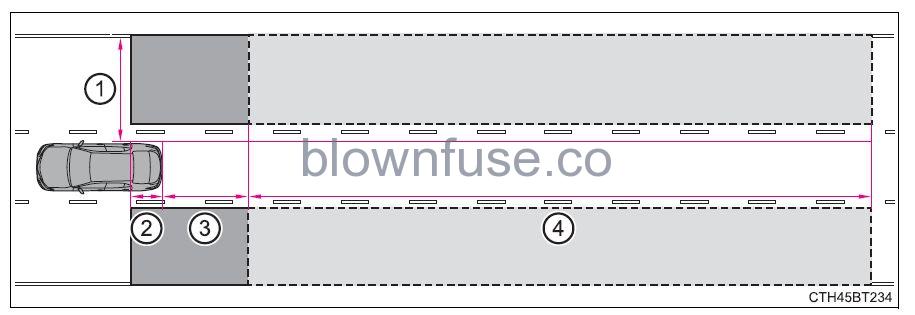
The areas in that vehicles can be detected are outlined below. The range of the detection area extends to:
- Approximately 1.6 ft. (0.5 m) to 11.5 ft. (3.5 m) from either side of the vehicle
- The area between the side of the vehicle and 1.6 ft. (0.5 m) from the side of the vehicle cannot be detected
- Approximately 3.3 ft. (1 m) forward of the rear bumper
- Approximately 9.8 ft. (3 m) from the rear bumper
- Approximately 9.8 ft. (3 m) to 197 ft. (60 m) from the rear bumper The greater the difference in speed between your vehicle and the detected vehicle is, the farther away the vehicle will be detected, causing the outside rearview mirror indicator to illuminate or flash
WARNING
Cautions regarding the use of the system The driver is solely responsible for safe driving. Always drive safely, taking care to observe your surroundings. The BSM function is a supplementary function that alerts the driver that a vehicle is present in the blind spot. Do not overly rely on the BSM function. The function cannot judge if it is safe to change lanes, therefore reliance could cause an accident resulting in death or serious injury. According to conditions, the system may not function correctly. Therefore the driver’s own visual confirmation of safety is necessary.
- The BSM function is operational when
- The BSM function is turned on
- Vehicle speed is greater than approximately 10 mph (16 km/h).
- The BSM function will detect a vehicle when
- A vehicle in an adjacent lane overtakes your vehicle.
- Your vehicle overtakes a vehicle in an adjacent lane slowly.
- Another vehicle enters the detection area when it changes lanes.
- Conditions under which the system will not detect a vehicle The BSM function is not designed to detect the following types of vehicles and/or objects:
- Small motorcycles, bicycles, pedestrians, etc.*
- Vehicles traveling in the opposite direction
- Guardrails, walls, signs, parked vehicles, and similar stationary objects*
- Following vehicles that are in the same lane*
- Vehicles driving 2 lanes across from your vehicle*
- Vehicles that are being overtaken rapidly by your vehicle
Depending on the conditions, detection of a vehicle and/or object may occur.
Conditions under which the system may not function correctly
The BSM function may not detect vehicles correctly in the following conditions:
- When the sensor is misaligned due to a strong impact on the sensor or its surrounding area
- When driving on a road surface that is wet with standing water during bad weather, such as heavy rain, snow, or fog
- When mud, snow, ice, a sticker, etc. is covering the sensor or surrounding area on the rear bumper
- When there is a significant difference in speed between your vehicle and the vehicle that enters the detection area
- When a vehicle is in the detection area from a stop and remains in the detection area as your vehicle accelerates
- When driving up or down consecutive steep inclines, such as hills, a dip on the road, etc.
- When driving on roads with sharp bends, consecutive curves, or uneven surfaces
- When multiple vehicles are approaching with only a small gap between each vehicle
- When vehicle lanes are wide, or when driving on the edge of a lane, and the vehicle in an adjacent lane is far away from your vehicle
- When the vehicle that enters the detection area is traveling at about the same speed as your vehicle
- When there is a significant difference in height between your vehicle and the vehicle that enters the detection area
- Directly after the BSM function is turned on
Instances of the BSM function unnecessarily detecting a vehicle and/or object may increase under the following conditions:
- When the sensor is misaligned due to a strong impact to the sensor or its surrounding area
- When the distance between your vehicle and a guardrail, wall, etc. that enters the detection area is short
- When there is only a short distance between your vehicle and the following vehicle
- When vehicle lanes are narrow, or when driving on the edge of a lane, and a vehicle traveling in a lane other than the adjacent lanes enters the detection area
- When items such as a bicycle carrier are installed on the rear of the vehicle
- When driving up and down consecutive steep inclines, such as hills, dips on the road, etc.
- When driving on roads with sharp bends, consecutive curves, or uneven surfaces
Intuitive parking assist
The distance from your vehicle to nearby objects when parallel parking or maneuvering into a garage is measured by the sensors and communicated via the multi-information display and a buzzer. Always check the surrounding area when using this system.
Types of sensors
- Front corner sensors
- Front center sensors
- Rear corner sensors
- Rear center sensors
Turning the intuitive parking assist on/off
- Press
 of the meter control switches, select
of the meter control switches, select  .
. - Press
 of the meter control switches, select
of the meter control switches, select  .
. - Press of the meter control switch.
- When the intuitive parking assist function is disabled, the intuitive parking assists OFF indicator (P. 91) illuminates.
- To re-enable the system, select
 the multi-information display, select
the multi-information display, select  , and turn it on.
, and turn it on. - If the system is disabled, it will remain off even if the engine switch is turned to IGNITION ON mode after the engine switch has been turned off.
Display
When the sensors detect an object, the following displays inform the driver of the position and distance to the object.
- Front corner sensor operation
- Front center sensor operation
- Rear corner sensor operation
- Rear center sensor operation
- Select to mute the buzzer sounds.
Muting the buzzer sound
- To mute the buzzer sound
- The buzzer can be temporarily muted by pressing of the meter control switches while an object detection display is shown on the multi-information display.
- To cancel the mute Mute will be automatically canceled in the following situations.
- When the shift position is changed
- When the vehicle speed exceeds a certain speed.
- When the intuitive parking assist is turned off once and turned on again
- When the engine switch is turned off once and turned to IGNITION ON mode again
- When a sensor is malfunctioning
Sensor detection display, object distance
Distance display
|
Display |
Approximate distance to object | ||
| Front and rear center sensor | Front and rear corner sensor | ||
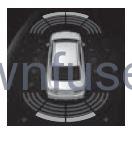 |
Far | Front center sensor:
3.3 ft. (100 cm) to 2.0 ft. (60 cm) Rear center sensor: 4.9 ft. (150 cm) to 2.0 ft. (60 cm) |
¾ |
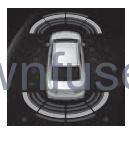 |
2.0 ft. (60 cm) to 1.5 ft. (45 cm) |
2.0 ft. (60 cm) to 1.5 ft. (45 cm) |
|
 |
1.5 ft. (45 cm) to 1.0 ft. (30 cm) |
1.5 ft. (45 cm) to 1.0 ft. (30 cm) |
|
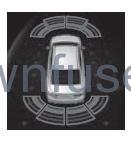 |
1.0 ft. (30 cm) to 0.5 ft. (15 cm) |
1.0 ft. (30 cm) to 0.5 ft. (15 cm) |
|
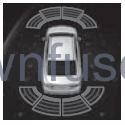 |
Near |
Less than 0.5 ft. (15 cm) |
Less than 0.5 ft. (15 cm) |
- Buzzer operation and distance to an object
- A buzzer sounds when the sensors are operating.
- The buzzer sounds faster as the vehicle approaches an object. When the vehicle comes within the following distance of the object, the buzzer sounds continuous: Approximately 1.0 ft. (30 cm).
- When 2 or more objects are detected simultaneously, the buzzer system responds to the nearest object. If one or both come within the above distances, the beep will repeat a long tone, followed by fast beeps.
- Automatic buzzer mute function
- After a buzzer begins sounding, if the distance between the vehicle and the detected object does not become shorter, the buzzer will be muted automatically. (However, if the distance between the vehicle and object is 1.0 ft.(30 cm) or less, this function will not operate.)
Detection range of the sensors
- Approximately 3.3 ft. (100 cm)
- Approximately 4.9 ft. (150 cm)
- Approximately 2.0 ft. (60 cm)
- The diagram shows the detection range of the sensors. Note that the sensors cannot detect objects that are extremely close to the vehicle.
- The range of the sensors may change depending on the shape of the object, etc.
Changing the buzzer sound volume
The buzzer volume can be changed on the multi-information display P. 120) when the engine switch is in IGNITION ON mode.
The system can be operated when
- The engine switch is in IGNITION ON mode.
- The intuitive parking assist function is on.
- The vehicle speed is less than about 6 mph (10 km/h).
- The shift lever is in other than P.
If “Parking Assist Unavailable Clean Parking Assist Sensor” is displayed on the multi-information display
A sensor may be dirty or covered with snow or ice. In such cases, if it is removed from the sensor, the system should return to normal.
Also, due to the sensor being frozen at low temperatures, a malfunction dis-play may appear or an object may not be detected. If the sensor thaws out, the system should return to normal.
If “Parking Assist Unavailable” is displayed on the multi-information display
Water may be continuously flowing over the sensor surface, such as in heavy rain. When the system determines that it is normal, the system will return to normal.
Sensor detection information
- The sensor’s detection areas are limited to the areas around the vehicle’s front and rear bumpers.
- The following situations may occur during use.
- Depending on the shape of the object and other factors, the detection distance may shorten, or detection may be impossible.
- Detection may be impossible if static objects draw too close to the sensor.
- There will be a short delay between static object detection and display (warning buzzer sounds). Even at low speeds, there is a possibility that the object will come within 1.0 ft. (30 cm) before the display is shown and the warning buzzer sounds.
- It might be difficult to hear the buzzer due to the volume of the audio system or the airflow noise of the air conditioning system.
- It may be difficult to hear the sound of this system due to the buzzers of other systems.
Objects which the system may not be properly detected
The shape of the object may prevent the sensor from detecting it. Pay particular attention to the following objects:
- Wires, fences, ropes, etc.
- Cotton, snow, and other materials that absorb sound waves
- Sharply-angled objects
- Low objects
- Tall objects with upper sections projecting outwards in the direction of your vehicle
Situations in which the system may not operate properly
Certain vehicle conditions and the surrounding environment may affect the ability of a sensor to correctly detect objects. Particular instances where this may occur are listed below.
- There is dirt, snow, water drops, or ice on a sensor. (Cleaning the sensors will resolve this problem.)
- A sensor is frozen. (Thawing the area will resolve this problem.) In especially cold weather, if a sensor is frozen the sensor display may be displayed abnormally, or objects, such as a wall, may not be detected.
- When a sensor or the area around a sensor is extremely hot or cold.
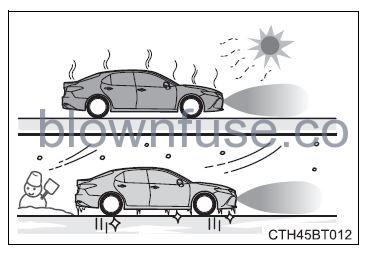
- On an extremely bumpy road, on an incline, on gravel, or on grass.
- When vehicle horns, vehicle detectors, motorcycle engines, air brakes of large vehicles, the clearance sonar of other vehicles or other devices which produce ultrasonic waves are near the vehicle
- A sensor is coated with a sheet of spray or heavy rain.
- If objects draw too close to the sensor.
- When a pedestrian is wearing clothing that does not reflect ultrasonic waves (ex. skirts with gathers or frills).
- When objects that are not perpendicular to the ground, not perpendicular to the vehicle traveling direction, uneven, or waving are in the detection range.
- Strong wind is blowing
- When driving in inclement weather such as fog, snow, or a sandstorm
- When an object that cannot be detected is between the vehicle and a detected object
- If an object such as a vehicle, motorcycle, bicycle, or pedestrian cuts in front of the vehicle or runs out from the side of the vehicle
- If the orientation of a sensor has been changed due to a collision or other impact
- When equipment that may obstruct a sensor is installed, such as a towing eyelet, bumper protector (an additional trim strip, etc.), bicycle carrier, or snow plow
- If the front of the vehicle is raised or lowered due to the carried load
- If the vehicle cannot be driven in a stable manner, such as when the vehicle has been in an accident or is malfunctioning
- When a tire chain or compact spare tire is used
Situations in which the system may operate even if there is no possibility of a collision In some situations, such as the following, the system may operate even though there is no possibility of a collision.
- When driving on a narrow road
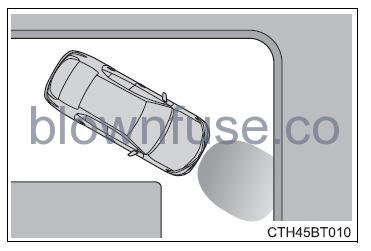
- When driving toward a banner, flag, low-hanging branch, or boom barrier (such as those used at railroad crossings, toll gates, and parking lots)
- When there is a rut or hole in the surface of the road
- When driving on a metal cover (grating), such as those used for drainage ditches
- When driving up or down a steep slope
- If a sensor is hit by a large amount of water, such as when driving on a flooded road
- There is dirt, snow, water drops or ice on a sensor. (Cleaning the sensors will resolve this problem.)
- A sensor is coated with a sheet of spray or heavy rain
- When driving in inclement weather such as fog, snow, or a sandstorm
- When strong winds are blowing
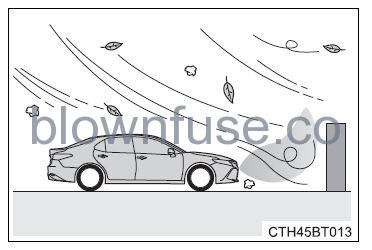
- When vehicle horns, vehicle detectors, motorcycle engines, air brakes of large vehicles, the clearance sonar of other vehicles or other devices which produce ultrasonic waves are near the vehicle
- If the front of the vehicle is raised or lowered due to the carried load
- If the orientation of a sensor has been changed due to a collision or other impact
- The vehicle is approaching a tall or curved curb
- Driving close to columns (H-shaped steel beams, etc.) in multi-story parking garages, construction sites, etc.
- If the vehicle cannot be driven in a stable manner, such as when the vehicle has been in an accident or is malfunctioning
- On an extremely bumpy road, on an incline, on gravel, or on grass
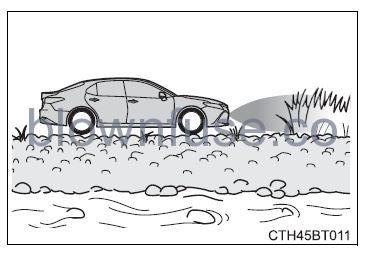
- When a tire chain or compact spare tire is used
WARNING
- Cautions regarding the use of the system There is a limit to the degree of recognition accuracy and control performance that this system can provide, do not overly rely on this system. The driver is always responsible for paying attention to the vehicle’s surroundings and driving safely.
- To ensure the system can operate properly Observe the following precautions.
Failing to do so may result in the vehicle being unable to be driven safely and possibly cause an accident.- Do not damage the sensors, and always keep them clean.
- Do not attach a sticker or install an electronic component, such as a backlit license plate (especially fluorescent type), fog lights, fender pole or wire-less antenna near a radar sensor.
- Do not subject the surrounding area of the sensor to a strong impact. If subjected to an impact, have the vehicle inspected by your Toyota dealer. If the front or rear bumper needs to be removed/installed or replaced, contact your Toyota dealer.
- Do not modify, disassemble or paint the sensors.
- Do not attach a license plate cover.
- Keep your tires properly inflated.
- When to disable the function In the following situations, disable the function as it may operate even though there is no possibility of a collision.
- Failing to observe the warnings above.
- A non-genuine Toyota suspension (lowered suspension, etc.) is installed.
- Notes when washing the vehicle Do not apply intensive bursts of water or steam to the sensor area.
Doing so may result in the sensor malfunctioning.- When using a high-pressure washer to wash the vehicle, do not spray the sensors directly, as doing so may cause a sensor to malfunction.
- When using steam to clean the vehicle, do not direct steam too close to the sensors as doing so may cause a sensor to malfunction.
- When using an automatic car wash, disable the intuitive parking assist
RCTA (Rear Cross Traffic Alert)
The RCTA function uses the BSM rear side radar sensors installed behind the rear bumper. This function is intended to assist the driver in checking areas that are not easily visible when backing up.
System components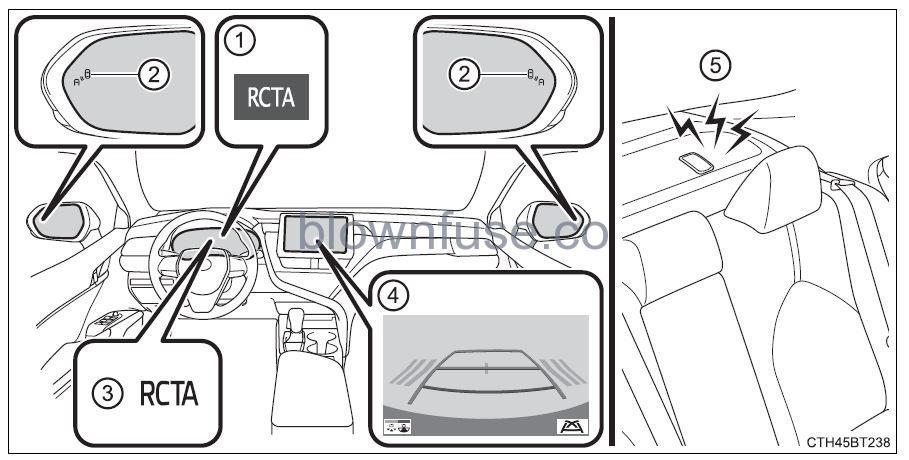
- Multi-information display
- Turning the RCTA function on/off. (P. 346)
- Outside rearview mirror indicators
- When a vehicle approaching from the right or left rear of the vehicle is detected, the outside rearview mirror indicators flash.
- “RCTA” indicator
- When the RCTA function is turned on, the indicator illuminates.
- Audio system screen
- If a vehicle approaching from the right or left at the rear of the vehicle is detected, the RCTA icon (P. 347) for the detected side will be displayed. This illustration shows an example of a vehicle approaching from both sides of the vehicle.
- RCTA buzzer
- When a vehicle approaching from the right or left rear of the vehicle is detected, a buzzer sounds from behind the rear seat.
Turning the RCTA function on/off
- Vehicles with 4.2-inch multi-information display
- Press
 of the meter control switches, select
of the meter control switches, select  .
. - Press
 of the meter control switches, select
of the meter control switches, select  .
. - Press
 of the meter control switch.
of the meter control switch. - Each time
 is pressed, the function changes on/off.
is pressed, the function changes on/off.
- Press
- Vehicles with 7-inch multi-information display
- Press
 of the meter control switches, select
of the meter control switches, select  .
. - Press
 of the meter control switches, select
of the meter control switches, select  .
. - Press
 of the meter control switch.
of the meter control switch. - Each time
 is pressed, the function changes on/off.
is pressed, the function changes on/off.
- Press
Setting the buzzer volume
The volume of the RCTA buzzer can be changed on  (4.2-inch display) or
(4.2-inch display) or 
 (7-inch display) (P. 106, 119) of the multi-information display.
(7-inch display) (P. 106, 119) of the multi-information display.
- The outside rearview mirror indicators’ visibility
- When under strong sunlight, the outside rearview mirror indicator may be difficult to see.
- RCTA buzzer hearing
- RCTA function may be difficult to hear over loud noises such as high audio volume.
- Muting the buzzer sound
- The buzzer can be temporarily muted by pressing
 the meter control switches while an object detection display is shown on the multi-information display.
the meter control switches while an object detection display is shown on the multi-information display.
- The buzzer can be temporarily muted by pressing
- When “Rear Cross Traffic Alert Unavailable” is shown on the multi-information display
- Ice, snow, mud, etc., may be attached to the rear bumper around the sensors. ( P. 332)
- The system should return to normal operation after removing the ice, snow, mud, etc. from the rear bumper.
- Additionally, the sensors may not operate normally when driving in extremely hot or cold environments.
- Rear side radar sensors P. 332
RCTA function
The RCTA functions when your vehicle is in reverse. It can detect other vehicles approaching from the right or left rear of the vehicle. It uses radar sensors to alert the driver of the other vehicle’s existence by flashing the outside rearview mirror indicators and sounding a buzzer.
- Approaching vehicles
- Detection areas
RCTA icon display (if equipped)
When a vehicle approaching from the right or left at the rear of the vehicle is detected, the following will be displayed on the audio system screen.
WARNING
- Cautions regarding the use of the system
- There is a limit to the degree of recognition accuracy and control performance that this system can provide, do not overly rely on this system. The driver is always responsible for paying attention to the vehicle’s surroundings and driving safely. (P. 334)
- To ensure the system can operate properly P. 332
RCTA function detection areas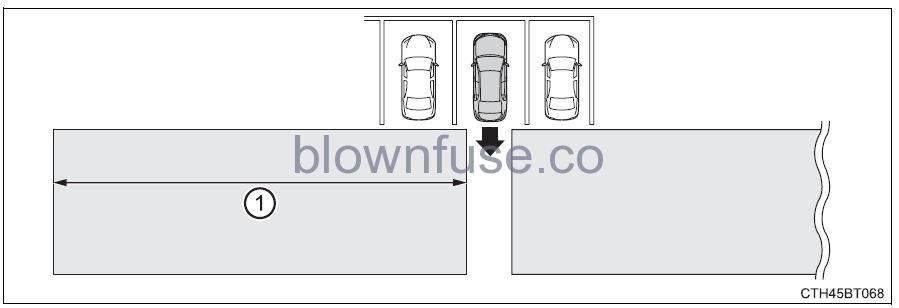
The areas in that vehicles can be detected are outlined below. To give the driver a more consistent time to react, the buzzer can alert faster vehicles from farther away.
Example
| Approaching vehicle | Speed | 1 Approximate alert distance |
| Fast | 18 mph (28 km/h) | 65 ft. (20 m) |
| Slow | 5 mph (8 km/h) | 18 ft. (5.5 m) |
The RCTA function is operational when
- Vehicles without a smart key system: The engine switch is in the “ON” position. Vehicles with a smart key system: The engine switch is in IGNITION ON mode.
- The RCTA function is turned on.
- The shift lever is in R.
- The vehicle speed is approximately 5 mph (8 km/h) or less.
- The approaching vehicle speed is between approximately 5 mph (8 km/h) and 18 mph (28 km/h).
Conditions under which the system will not detect a vehicle
The RCTA function is not designed to detect the following types of vehicles and/or objects:
- Vehicles approaching from directly behind
- Vehicles backing up in the parking space next to your vehicle*
- Vehicles that the sensors cannot detect due to obstructions

- Guardrails, walls, signs, parked vehicles, and similar stationary objects*
- Small motorcycles, bicycles, pedestrians, etc.*
- Vehicles moving away from your vehicle
- Vehicles approaching from the parking spaces next to your vehicle*
- The distance between the sensor and the approaching vehicle gets too close
Depending on the conditions, detection of a vehicle and/or object may occur.
Situations in which the system may not operate properly
The RCTA function may not detect vehicles correctly in the following situations:
- When the sensor is misaligned due to a strong impact on the sensor or its surrounding area
- When mud, snow, ice, a sticker, etc., is covering the sensor or surrounding area on the position above the rear bumper
- When driving on a road surface that is wet with standing water during bad weather, such as heavy rain, snow, or fog
- When multiple vehicles are approaching with only a small gap between each vehicle
- When a vehicle is approaching at a high speed
- When equipment that may obstruct a sensor is installed, such as a towing eyelet, bumper protector (an additional trim strip, etc.), bicycle carrier, or snow plow
- When backing up on a slope with a sharp change in grade

- When backing out of a sharp angle parking spot
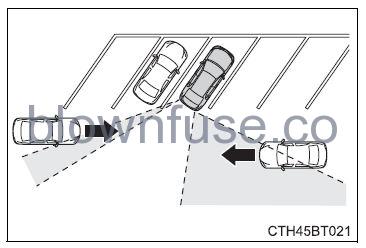
- When towing a trailer
- When there is a significant difference in height between your vehicle and the vehicle that enters the detection area
- When a sensor or the area around a sensor is extremely hot or cold
- If the suspension has been modified or tires of a size other than specified are installed
- If the front of the vehicle is raised or lowered due to the carried load
- When turning while backing up
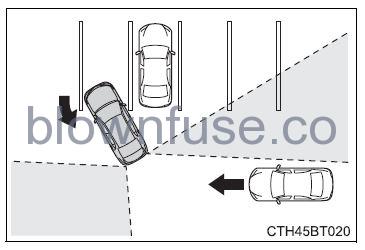
- When a vehicle turns into the detection area

Situations in which the system may operate even if there is no possibility of a collision
Instances of the RCTA function unnecessary detecting a vehicle and/or object may increase in the following situations:
- When the parking space faces a street and vehicles are being driven on the street
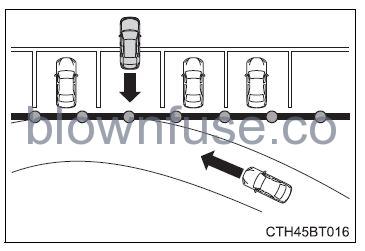
- When the distance between your vehicle and metal objects, such as a guardrail, wall, sigh, or parked vehicle, which may reflect electrical waves toward the rear of the vehicle, is short

- When equipment that may obstruct a sensor is installed, such as a towing eyelet, bumper protector (an additional trim strip, etc.), bicycle carrier, or snow plow
- When a vehicle passes by the side of your vehicle
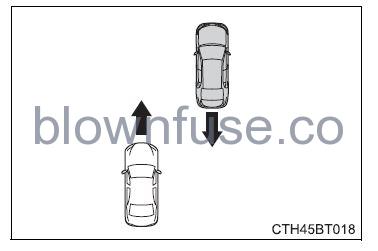
- When a detected vehicle turns while approaching the vehicle
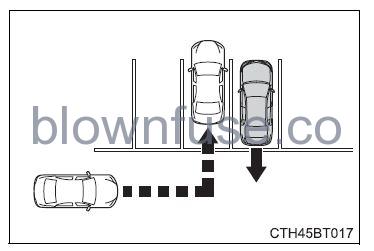
- When there are spinning objects near your vehicle such as the fan of an air conditioning unit
- When water is splashed or sprayed a sprinkler
- Moving objects (flags, exhaust fumes, large rain droplets or snowflakes, rainwater on the road surface, etc.)
- When the distance between your vehicle and a guardrail, wall, etc., that enters the detection area is short
- Gratings and gutters
- When a sensor or the area around a sensor is extremely hot or cold
- If the suspension has been modified or tires of a size other than specified are installed
- If the front of the vehicle is raised or lowered due to the carried load
RCD (Rear Camera Detection)
When the vehicle is backing up, the rear camera detection function can detect pedestrians in the detection area behind the vehicle. If a pedestrian is detected, a buzzer will sound and an icon on the audio system screen will be displayed to inform the driver of the pedestrian.
Display
- Toyota parking assist monitor
- Panoramic view monitor
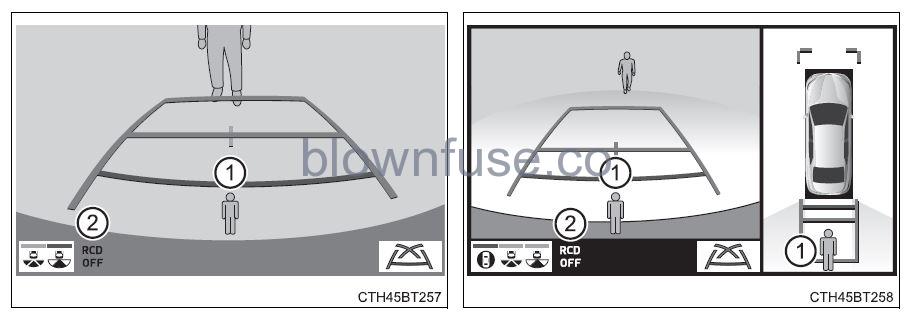
- The pedestrian detection icon is Displayed automatically when a pedestrian is detected.
- RCD OFF icon When the RCD function is disabled, the RCD OFF icon illuminates.
Turning the rear camera detection function on/off
- Vehicles with 4.2-inch multi-information display
- Press
 of the meter control switches, select
of the meter control switches, select  .
. - Press
 of the meter control switches, select
of the meter control switches, select  .
. - Press
 of the meter control switch.
of the meter control switch. - When the RCD function is disabled, the RCD OFF indicator (P. 91) illuminates.
- Press
- Vehicles with 7-inch multi-information display
- Press
 of the meter control switches, select
of the meter control switches, select  .
. - Press
 of the meter control switches, select
of the meter control switches, select  .
. - Press of the meter control switch.
- When the RCD function is disabled, the RCD OFF indicator (P. 91) illuminates.
- Press
When a pedestrian is detected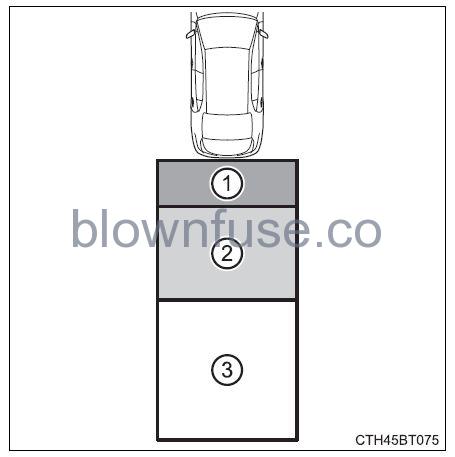
If the rear camera detection function detects a pedestrian in the detection area, the buzzer and icon will operate as shown in the following table:
| Area | Buzzer | Icon |
| 1 | Sounds repeatedly |
Blinks 3 times and then stays on |
|
2 |
When the vehicle is stationary: Sounds 3 times
When the vehicle is backing up: Sounds repeatedly |
|
|
3 |
When it is determined that a pedestrian will enter area 1 within a few seconds: Sounds repeatedly | When it is determined that a pedestrian will enter area 1 within a few seconds: Blinks 3 times and then stays on |
- The rear camera detection function is operational when
The rear camera detection function is operational when the following conditions are met:- The engine switch is in the “ON” position (vehicles without a smart key system) or in IGNITION ON mode (vehicles with a smart key system).
- RCD function is on.
- The shift lever is in R.
- Setting the buzzer volume
- Muting the buzzer sound
- The buzzer can be temporarily muted by pressing of the meter control switches while an object detection display is shown on the multi-information display.
- If “Rear Camera Detection Unavailable Remove the Dirt of Rear Camera” is displayed on the multi-information display
- A rear camera lens may be dirty or covered with snow or ice. In such cases, if it is removed from the rear camera lens, the system should return to normal. (It may be necessary to drive the vehicle for some time before the system returns to normal.)
- If “Rear Camera Detection Unavailable” is displayed on the multi-information display
- If this message is displayed after the battery has been disconnected and reconnected, fully turn the steering wheel to the left and then to the right on level ground.
- If this message is displayed only when the R shift position is selected, the rear camera lens may be dirty. Clean the rear camera lens.
Situations in which the system may not operate properly
- Some pedestrians, such as the following, may not be detected by the rear camera detection function, preventing the function from operating properly:
- Pedestrians who are squatting
- Pedestrians who are lying down
- Pedestrians who are running
- Pedestrians who suddenly enter the detection area
- Pedestrians riding a bicycle, skateboard, or another light vehicle
- Pedestrians wearing unusual clothing, such as a costume
- Pedestrians whose body is partially hidden by a cart or other object
- Pedestrians which are obscured by darkness, such as at night
- In some situations, such as the following, pedestrians may not be detected by the rear camera detection function, preventing the function from operating properly:
- When backing up in inclement weather (rain, snow, fog, etc.)
- When the rear camera is obscured (dirt, snow, ice, etc. are attached) or scratched
- When a very bright light, such as the sun, or the headlights of another vehicle, shines directly into the rear camera
- When backing up in a place where the surrounding brightness changes suddenly, such as at the entrance or exit of a garage or underground parking lot
- When backing up in a dim environment such as during dusk or in an underground parking lot
- When the camera position and direction deviate
- When a towing hook is attached
- When water droplets are flowing on the camera lens
- When the vehicle height is extremely changed (nose up, nose down)
- When tire chains is used
Situations in which the system may operate unexpectedly
- Even though there are no pedestrians in the detection area, some objects, such as the following, maybe detected, possibly causing the rear camera detection function to operate.
- Three-dimensional objects, such as a pole, traffic cone, fence, or parked vehicle
- Moving objects, such as a car or motorcycle
- Objects moving toward your vehicle when backing up, such as flags or puddles (or airborne matter, such as smoke, steam, rain, or snow)
- Cobblestone or gravel roads, tram rails, road repairs, white lines, pedestrian crossings or fallen leaves on the road
- Metal covers (gratings), such as those used for drainage ditches
- Objects reflected in a puddle or on a wet road surface
- Shadows on the road
- In some situations, such as the following, the rear camera detection function may operate even though there are no pedestrians in the detection area.
- When backing up toward the roadside or a bump on the road
- When backing up toward an incline/decline
- If the rear of the vehicle is raised or lowered due to the carried load
- If a bumper protector, such as an additional trim strip, is installed to the rear bumper
- If the orientation of the rear camera has been changed
- If a towing eyelet is installed to the rear of the vehicle
- When the rear camera is obscured (dirt, snow, ice, etc. are attached) or scratched
- When water is flowing over the rear camera lens
- If there is a flashing light in the detection area, such as the emergency flashers of another vehicle
- When a tire chain is used
- Situations in which the rear camera detection function may be difficult to notice
- If the buzzer may be difficult to hear if the surrounding area is noisy, the volume of the audio system volume is high, the air conditioning system is being used, etc.
- If the temperature in the cabin is extremely high or low, the audio system screen may not operate correctly.
WARNING
- Cautions regarding the use of the system
- The recognition and control capabilities of this system are limited.
- The driver should always drive safely by always being responsible without over-relying on the system and having an understanding of the surrounding situations.
- To ensure the system can operate properly Observe the following, otherwise, there is a danger that could lead to an accident.
- Always clean the camera without damaging it.
- Do not install market electronic parts (such as Illuminated license plates, fog lamps, etc.) in the camera vicinity.
- Do not subject the camera vicinity to strong impacts. If the vicinity is subjected to a strong impact, have the vehicle inspected at your Toyota dealer.
- Do not disassemble, remodel or paint the camera.
- Do not attach accessories or stickers to the camera.
- Do not install market protection parts (bumper trim, etc.) to the rear bumper.
- Maintain suitable tire air pressure.
- Make sure the trunk is completely closed.
- RCD function is turned off In the following situations the system turns off. The RCD function may not operate properly and thus there is the danger that an accident may occur.
- The contents mentioned above are not observed.
- Suspensions other than Toyota genuine parts are installed.
PKSB (Parking Support Brake)
The Parking Support Brake system consists of the following functions that operate when driving at a low speed or backing up, such as when parking. When the system determines that the possibility of a collision with a detected object is high, a warning operates to urge the driver to take evasive action. If the system determines that the possibility of a collision with a detected object is extremely high, the brakes are automatically applied to help avoid the collision or help reduce the impact of the collision.
PKSB (Parking Support Brake) system
- Parking Support Brake function (static objects)
- Ultrasonic sensors are used to detect static objects, such as a wall, in the detection area when driving at a low speed or backing up. ( P. 368)
- Parking Support Brake function (rear-crossing vehicles) Rear radar sensors are used to detect approaching vehicles in the detection area behind the vehicle when backing up. (P. 372)
Types of sensors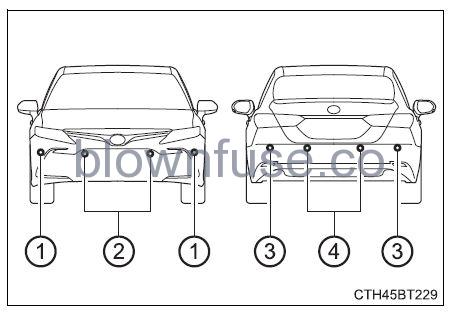

- Front corner sensors
- Front center sensors
- Rear corner sensors
- Rear center sensors
Turning the Parking Support Brake on/off
The Parking Support Brake can be enabled/disabled on the multi-information display. All of the Parking Support Brake functions (static objects and rear-crossing vehicles) are enabled/disabled simultaneously.
Use the meter control switches to enable/disable the parking support brake. (P. 103, 117)
- Press
 of the meter control switches, select
of the meter control switches, select  .
. - Press
 of the meter control switches, select
of the meter control switches, select  .
. - Press
 of the meter control switch.
of the meter control switch. - Select the “Yes” and push
 .
.
- When the Parking Support Brake is disabled, the PKSB OFF indicator illuminates.
- To re-enable the system when it was disabled, select
 on the multi-information display, select
on the multi-information display, select  and then “On”. If disabled using this method, the system will not be re-enabled by turning the engine switch off and then to IGNITION ON mode
and then “On”. If disabled using this method, the system will not be re-enabled by turning the engine switch off and then to IGNITION ON mode
Displays and buzzers for engine output restriction control and brake control
|
Control |
Situation |
Multi-information display | PKSB OFF
Indicator |
Buzzer |
| Engine output restriction con- trol is operating (acceleration restriction) | Acceleration greater than a certain amount is not possible. |
“Object Detected Acceleration Reduced” |
Not illuminated |
No beep |
| Engine output restriction con- trol is operating (output restricted as much as pos- sible) |
Stronger-than- normal brake operation is nec- essary. |
“Brake!” |
Not illu- minated |
Short beep |
| Brake control is operating | Emergency brak- ing is necessary. | |||
| Vehicle stopped by system opera- tion
(When accelera- tor is stepped on) |
The vehicle has been stopped by brake control operation. |
“Switch to Brake” |
Illumi- nated |
Short beep |
| Vehicle stopped by system opera- tion
(When accelera- tor is not stepped on) |
The vehicle has been stopped by brake control operation. |
“Brake” |
Illumi- nated |
Short beep |
If the engine output restriction control or brake control operates, a buzzer will sound and a message will be displayed on the multi-information display to alert the driver. Depending on the situation, engine output restriction control will operate to either limit acceleration or restrict output as much as possible.
Parking Support Brake function
If the Parking Support Brake detects that a collision with an object is possible, the engine output will be restricted to restrain any increase in the vehicle speed. (Engine output restriction control: See A below.)
Additionally, if the accelerator pedal continues to be depressed, the brakes will be applied automatically to reduce the vehicle speed.(Brake control: See B below.)
- Accelerator pedal
- Brake pedal
- Engine output
- Braking force
- Start of control
- High possibility of a collision
- Extremely high possibility of a collision
If the Parking Support Brake function has operated
If the vehicle is stopped due to the operation of the Parking Support Brake function, the Parking Support Brake system will be disabled and the PKSB OFF indicator will illuminate. If the Parking Support Brake operates unnecessarily, brake control can be canceled by depressing the brake pedal or waiting for approximately 2 seconds for it to automatically be canceled. Then, the vehicle can be operated by depressing the accelerator pedal.
Re-enabling the Parking Support Brake system
- To re-enable the Parking Support Brake system when it is disabled due to the operation of the Parking Support Brake function, either enable the system again (P. 361), or turn the engine switch off and then back to IGNITION ON mode.
- Additionally, if the object becomes no longer in the traveling direction of the vehicle or if the traveling direction of the vehicle changes (such as changing from moving forward to backing up, or from backing up to moving forward), the system will be re-enabled automatically.
If “PKSB Unavailable” and “Parking Assist Unavailable Clean Parking Assist Sensor” are displayed on the multi-information display and the PKSB OFF indicator is illuminating
- A sensor may be covered with ice, snow, dirt, etc. In this case, remove the ice, snow, dirt, etc., from the sensor to return the system to normal. If this message is shown even after removing dirt from the sensor, or shown when the sensor was not dirty, to begin with, have the vehicle inspected at your Toyota dealer.
- A sensor may be frozen. Once the ice melts, the system will return to normal.
- Water may be continuously flowing over the sensor surface, such as in heavy rain. When the system determines that it is normal, the system will return to normal.
WARNING
- Cautions regarding the use of the system Do not overly rely on the system, as doing so may lead to an accident. Always drive while checking the safety of the surroundings of the vehicle. Depending on the vehicle and road conditions, weather, etc., the system may not operate.
The detection capabilities of sensors and radars are limited. Always drive while checking the safety of the surroundings of the vehicle.- The driver is solely responsible for safe driving. Always drive carefully, taking care to observe your surroundings. The Parking Support Brake system is designed to provide support to lessen the severity of collisions. However, it may not operate in some situations.
- The Parking Support Brake system is not designed to stop the vehicle completely. Additionally, even if the system has stopped the vehicle, it is necessary to depress the brake pedal immediately as brake control will be canceled after approximately 2 seconds.
- It is extremely dangerous to check the system operations by intentionally driving the vehicle in the direction of a wall, etc. Never attempt such actions.
- When to disable the Parking Support Brake
In the following situations, disable the Parking Support Brake as the system may operate even though there is no possibility of a collision.- When inspecting the vehicle using a chassis roller, chassis dynamo, or free roller
- When loading the vehicle onto a boat, truck or another transport vessel
- If the suspension has been modified or tires of a size other than specified are installed
- If the front of the vehicle is raised or lowered due to the carried load
- When equipment that may obstruct a sensor is installed, such as a towing eyelet, bumper protector (an additional trim strip, etc.), bicycle carrier, or snow plow
- When using automatic car washing devices
- If the vehicle cannot be driven in a stable manner, such as when the vehicle has been in an accident or is malfunctioning
- When the vehicle is driven in a sporty manner or off-road
- When the tires are not properly inflated
- When the tires are very worn
- When a tire chain or compact spare tire is used
NOTICE
If “PKSB Unavailable” is displayed on the multi-information display and the PKSB OFF indicator is illuminating If this message is displayed immediately after the engine switch is changed to ON, operate the vehicle carefully, paying attention to your surroundings. It may be necessary to drive the vehicle for a certain amount of time before the system returns to normal. (If the system is not returned to normal after driving for a while, clean the sensors and their surrounding area on the bumpers.)
Parking Support Brake function (static objects)
If a collision with an object may occur due to the vehicle suddenly moving forward due to an accidental accelerator pedal operation, the vehicle moving in the unintended direction due to the wrong shift position being selected, or while parking or traveling at low speeds, the sensors detect objects, such as a wall, in the traveling direction of the vehicle, and the system operates to lessen an impact with an object and reduce the resulting damage.
Examples of system operation
The system will operate in situations such as the following if an object is detected in the traveling direction of the vehicle.
When traveling at a low speed and the brake pedal is not depressed or is depressed late
When the accelerator pedal is depressed excessively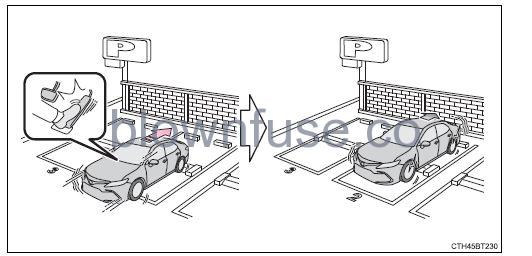
When the vehicle moves in the unintended direction due to the wrong shift position being selected
The Parking Support Brake function (static objects) will operate when The function will operate when the PKSB OFF indicator is not illuminated ( P. 361, 365) and all of the following conditions are met:
- Engine output restriction control
- The Parking Support Brake system is enabled.
- The vehicle speed is approximately 10 mph (15 km/h) or less.
- There is an object in the traveling direction of the vehicle and approximately 6 to 13 ft. (2 to 4 m) away.
- The system determines that a stronger-than-normal brake operation is necessary to avoid a collision.
- Brake control
- Engine output restriction control is operating.
- The system determines that an emergency brake operation is necessary to avoid a collision.
The Parking Support Brake function (static objects) will stop operating when
The function will stop operating if any of the following conditions are met:
- Engine output restriction control
- The Parking Support Brake system is disabled.
- The collision becomes avoidable with normal brake operation.
- The object is no longer approximately 6 to 13 ft. (2 to 4 m) away in the traveling direction of the vehicle.
- Brake control
- The Parking Support Brake system is disabled.
- Approximately 2 seconds elapse after the vehicle is stopped by brake control.
- The brake pedal is depressed after the vehicle is stopped by brake control.
- The object is no longer approximately 6 to 13 ft. (2 to 4 m) away in the traveling direction of the vehicle.
- Detection range of the Parking Support Brake function (static objects) The detection range of the Parking Support Brake function differs from the detection range of the intuitive parking assist. (P. 339)
- Therefore, even if the intuitive parking assist detects an object and provides a warning, the Parking Support Brake function may not start operating.
- Situations in which the system may not operate properly P. 341
- Situations in which the system may operate even if there is no possibility of a collision P. 342
WARNING
- To ensure the system can operate properly P. 344
- If the Parking Support Brake function (static objects) operates unnecessarily, such as at a railroad crossing P. 365
- Notes when washing the vehicle P. 344
Parking Support Brake function (rear-crossing vehicles)
If a radar sensor detects a vehicle approaching from the right or left at the rear of the vehicle and the system determines that the possibility of a collision is high, this function will perform brake control to reduce the likelihood of an impact with the approaching vehicle.
Examples of system operation
The system will operate in situations such as the following if an object is detected in the traveling direction of the vehicle.
When reversing, a vehicle is approaching and the brake pedal is not depressed or is depressed late
- The Parking Support Brake function (rear-crossing vehicles) will operate when The function will operate when the PKSB OFF indicator is not illuminated (P. 361, 365) and all of the following conditions are met:
- Engine output restriction control
- The Parking Support Brake is enabled.
- The vehicle speed is approximately 9 mph (15 km/h) or less.
- Vehicles which are approaching from the right or left at the rear of the vehicle at a traveling speed of approximately 5 mph (8 km/h) or more.
- The shift lever is in R.
- The system determines that a stronger than normal brake operation is necessary to avoid a collision with an approaching vehicle.
- Brake control
- Engine output restriction control is operating.
- The system determines that an emergency brake operation is necessary to avoid a collision with an approaching vehicle.
- The Parking Support Brake function (rear-crossing vehicles) will stop operating when
The function will stop operating if any of the following conditions are met:- Engine output restriction control
- The Parking Support Brake is disabled.
- The collision becomes avoidable with normal brake operation.
- A vehicle is no longer approaching from the right or left at the rear of the vehicle.
- Brake control
- The Parking Support Brake is disabled.
- Approximately 2 seconds elapse after the vehicle is stopped by brake control.
- The brake pedal is depressed after the vehicle is stopped by brake control.
- A vehicle is no longer approaching from the right or left at the rear of the vehicle.
- Engine output restriction control
- The detection area of the Parking Support Brake function (rear-crossing vehicles) The detection area of the Parking Support Brake function (rear-crossing vehicles) differs from the detection area of the RCTA function (P. 345).
- Therefore, even if the RCTA function detects a vehicle and provides an alert, the Parking Support Brake function (rear-crossing vehicles) may not start operating.
- Situations in which the system may not operate properly P. 351
- Situations in which the system may operate even if there is no possibility of a collision P. 352
WARNING
To ensure the system can operate properly P. 332
Driving mode select switches
The driving modes can be selected to suit the driving condition
- Normal mode
- Use for normal driving.
- While in Eco drive mode or sport mode, press the switch to change the driving mode to normal mode.
- Eco-drive mode
- Use Eco drive mode to help achieve low fuel consumption during trips that involve frequent accelerating.
- When the “ECO” switch is pressed, the “ECO MODE” indicator comes on in the instrument cluster.
- Sport mode
- Use sports mode when increased acceleration response and precise handling is desired, for example, when driving on mountain roads.
- When the “SPORT” switch is pressed, the “SPORT” indicator comes on in the instrument cluster.
Operation of the air conditioning system in Eco drive mode
Eco-drive mode controls the heating/cooling operations and the fan speed of the air conditioning system to enhance fuel-efficiency (P. 387, 394). To improve air conditioning performance, adjust the fan speed or turn off Eco drive mode.
Sport mode automatic deactivation
Sport mode is automatically deactivated if the engine switch is turned off after driving in sport mode.
